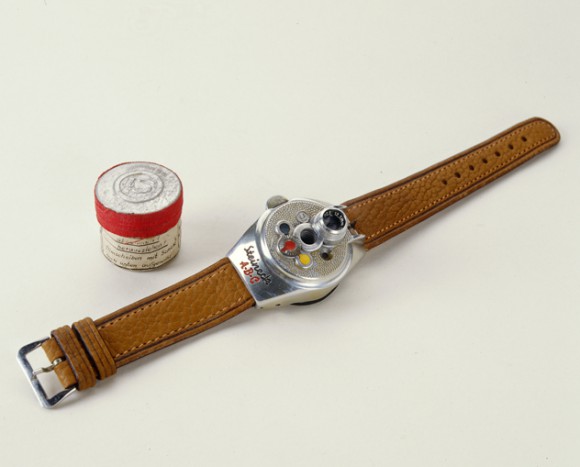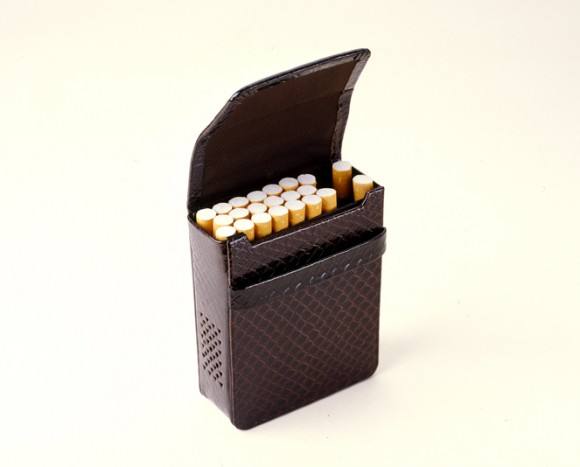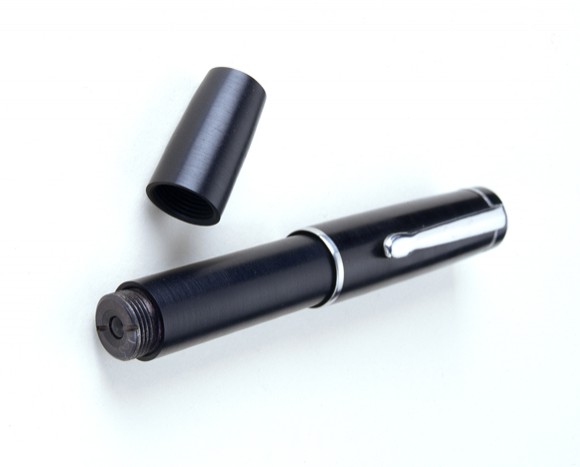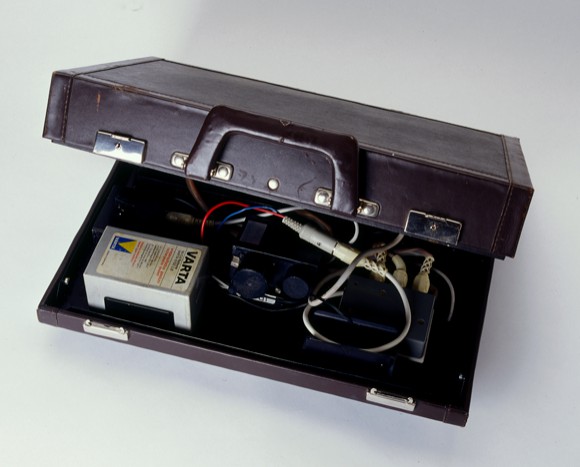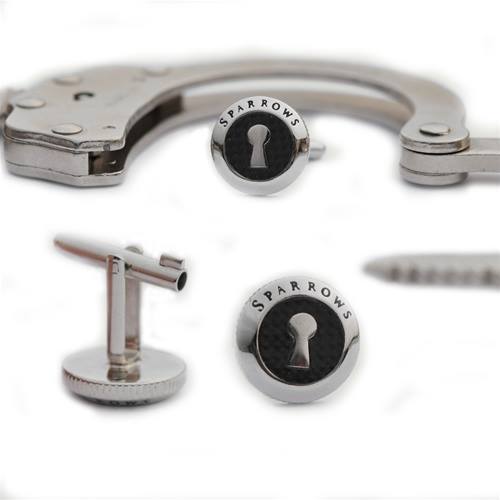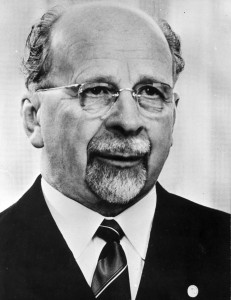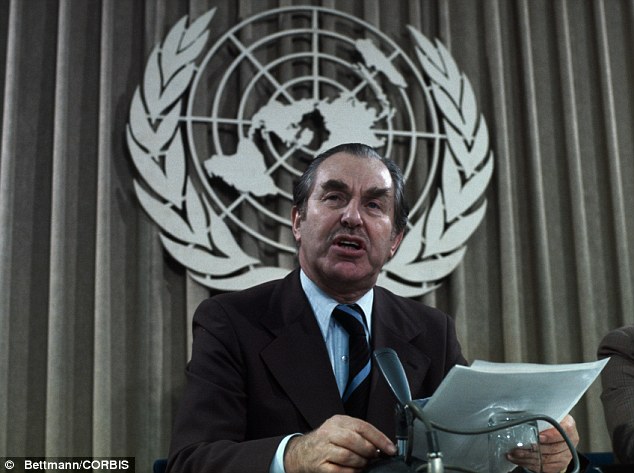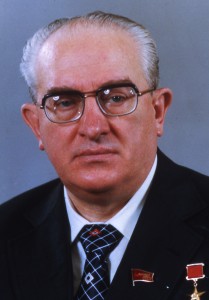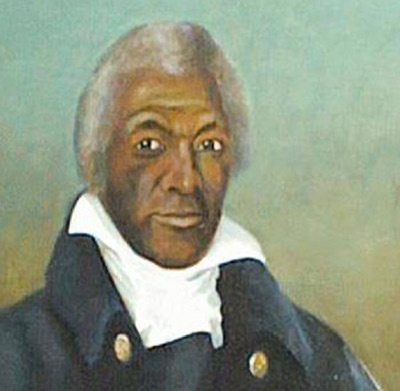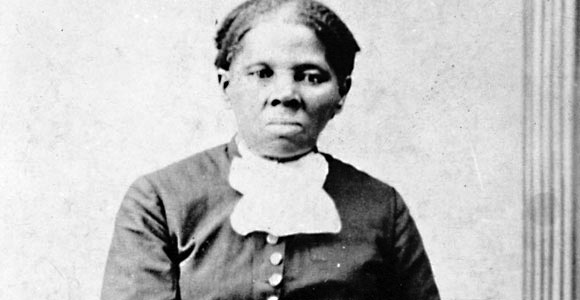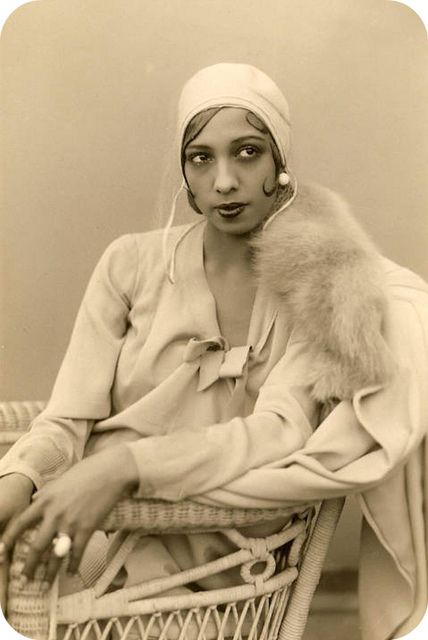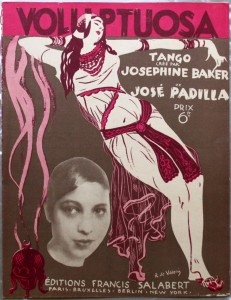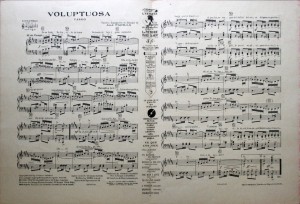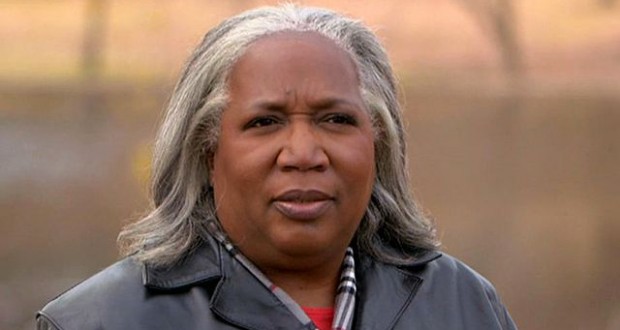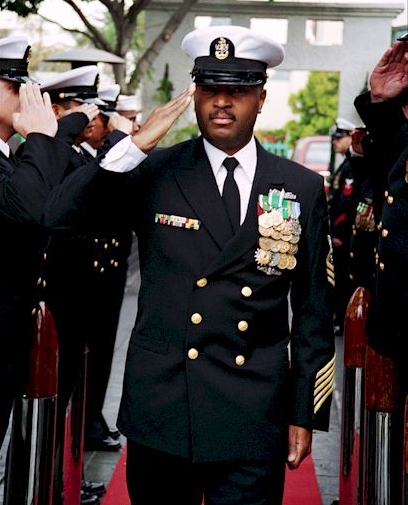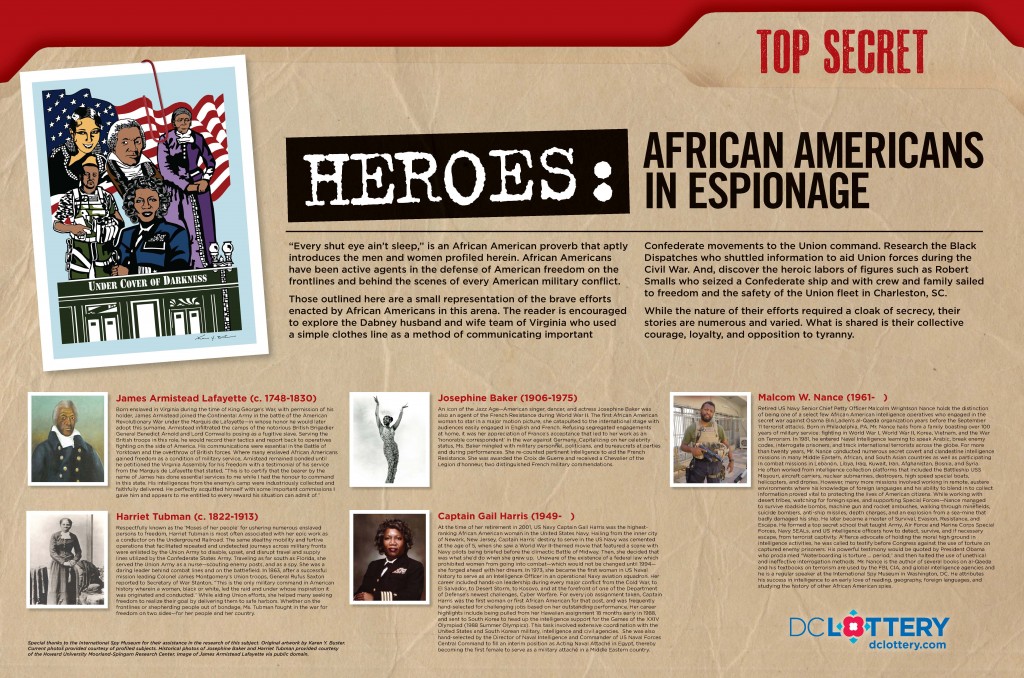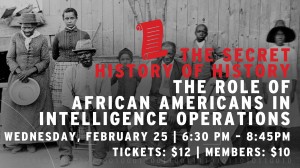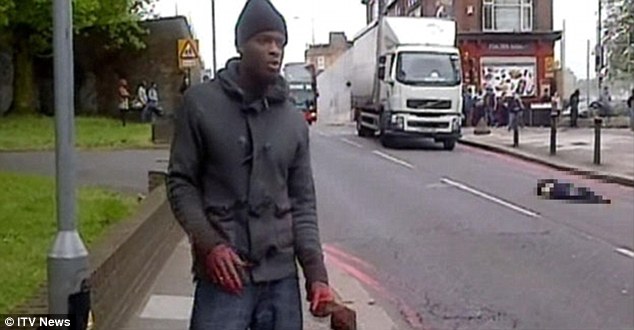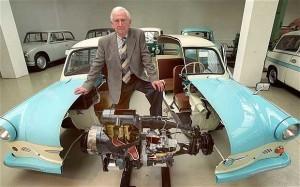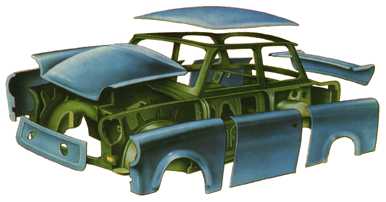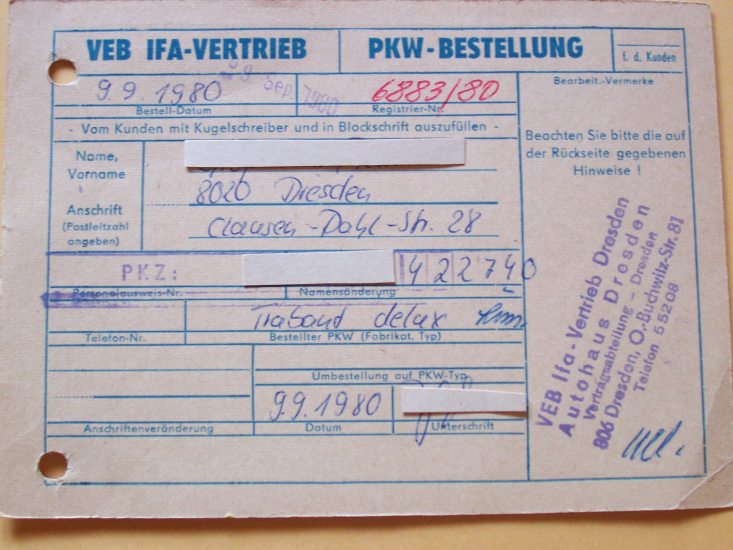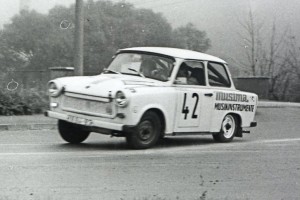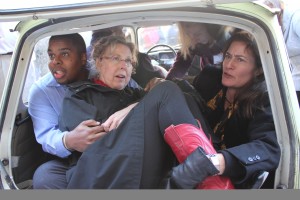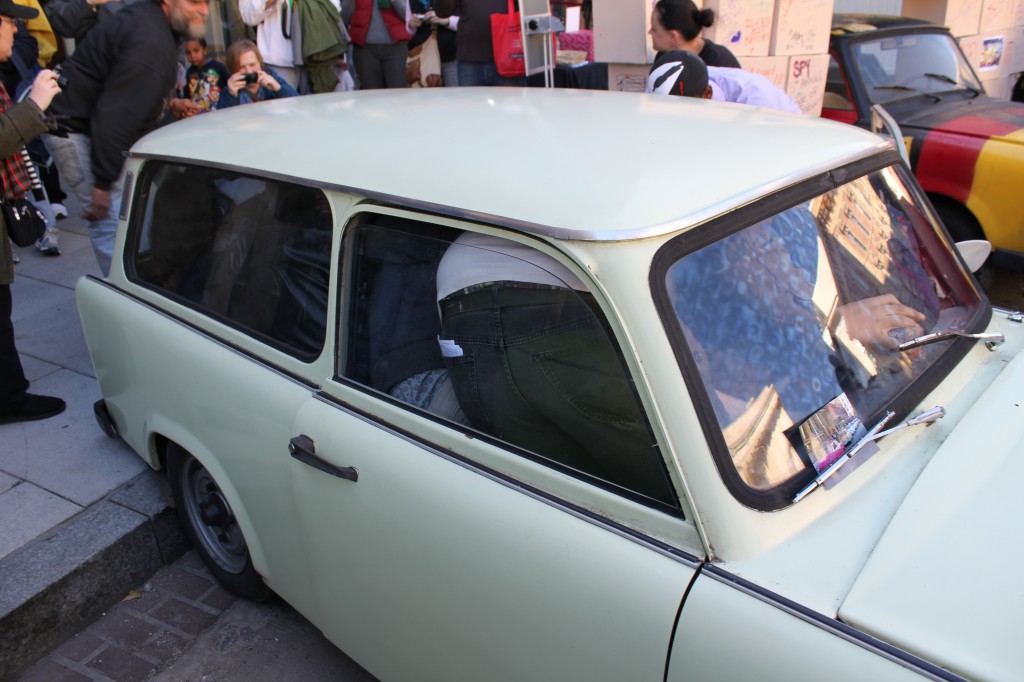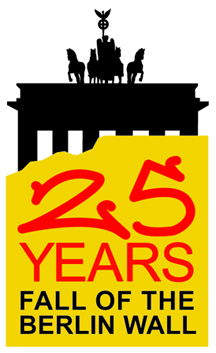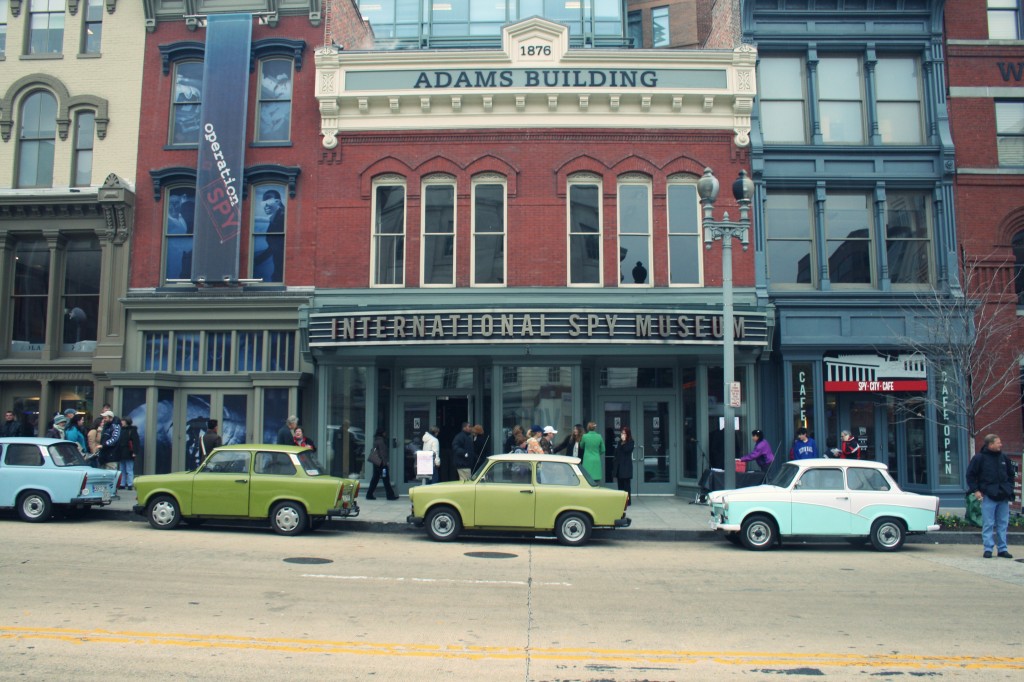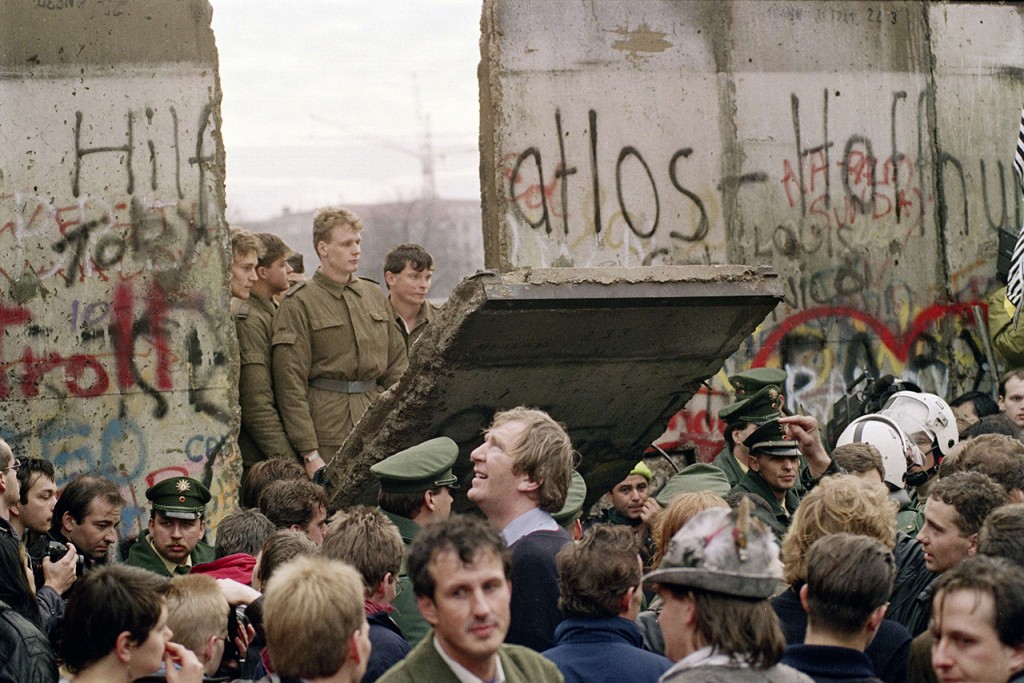
AFP PHOTO/GERARD MALIE
It has been 25 years since the the fall of the Berlin Wall. For many of us, Nov 9, 1989, marks the beginning of the end of the Cold War–although it would take another two years for the Soviet Union to formally dissolve. This year, people from around the world are gathering in Berlin to commemorate this historic event; Hope Harrison is one of them. Dr. Harrison is Associate Professor of History and International Affairs at George Washington University, a Senior Fellow in the History and Public Policy Program at the Wilson Center, and author of the forthcoming “After the Berlin Wall: Memory and the Making of the New Germany, 1989 to the Present.” Harrison was in Berlin in November 1989 and has journeyed back to participate in the festivities being held from Nov. 7 to Nov 9. She is blogging live for the Museum about her experiences and reflections.
—————————————————————-

November 6, 2014 — Potsdamer Platz
Tonight I met a friend for dinner in Potsdamer Platz before going to a concert at the Berlin Philharmonic. There are few places in Berlin that demonstrate so dramatically how much has changed here since the Wall came down. At the turn of the 19th to the 20th century, Potsdamer Platz was a bustling crossroads in the center of Berlin. Then it was destroyed in World War II.
After the war, this central part of the city fell under communist control. When the East Germans built the Berlin Wall in 1961, Potsdamer Platz was part of the so-called “death strip” of the Berlin Wall, a “no-man’s land” where only armed guards with a shoot to kill order were allowed. The Berlin Wall surrounded West Berlin with 96 miles of a fortified border which was up to 160 yards wide and featured an outer and inner wall with guard towers, trip wires, anti-vehicle obstacles, guard dogs, bright lights and armed guards between the two walls, all to make sure East Germans didn’t escape.

Potsdamer Platz (Before and After)
Since the fall of the Wall and German unification, Potsdamer Platz now features skyscrapers, movie theaters (the home of the annual Berlin movie festival, the Berlinale), restaurants, cafes, a casino, a shopping mall, and LEGOLAND. And it sits just across the street from the Philharmonic hall. I don’t particularly like the architecture at Potsdamer Platz (except for the dome of the Sony center, which lights up with a constantly changing array of colors), but I do like the fact that what once was a life-threatening area is now a hub of activity for people to enjoy life.
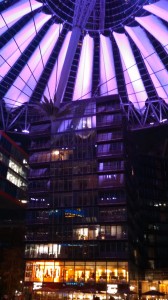
And so I picked this spot for dinner before the concert celebrating the 25th anniversary of the fall of the Wall. I am also celebrating a 25-year friendship with Claudia, a big-hearted Berliner I met on Nov. 10, 1989. By an incredible stroke of luck, I had flown to West Berlin on Nov. 9, 1989, on a long-planned trip with a group of graduate students from Harvard and Stanford. I no idea the Wall had fallen in the night while I was on the plane until I arrived in Frankfurt for the Pan Am flight to West Berlin. As I was looking around wondering why everyone was reading newspapers with headlines announcing “The Wall is open!”, the pilot announced, “Ladies and gentlemen, in case you haven’t heard, the Berlin Wall fell last night and we are flying into history!”
That night in West Berlin, Claudia was one of the West Berliners who came to meet with our group. She offered to drive me around the next day to see places where the Wall was being opened. It was an unforgettable experience. And we have stayed in touch ever since and visited each other many times.
Tonight, we celebrated 25 years of friendship with dinner at the Sony Center and Beethoven’s 9th with the Berlin Philharmonic. All we had to do was cross the street from Potsdamer Platz to the Philharmonic, no longer separated by a deadly and ugly wall.
–HMH
—————————————————————-
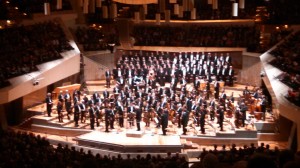 November 6, 2014 — Berlin Philharmonic & Beethoven’s 9th
November 6, 2014 — Berlin Philharmonic & Beethoven’s 9th
In honor of the 25th anniversary of the fall of the Berlin Wall, the Berlin Philharmonic Orchestra under maestro Sir Simon Rattle performed tonight Karol Szymanowski’s hauntingly beautiful “Stabat mater” and Ludwig van Beethoven’s 9th Symphony. The concert will be repeated on the actual 25th anniversary this Sunday (and live streamed on www.digital-concert-hall.com). The inspiring role played by Solidarity in Poland in the 1980s is the reason a Polish composer was chosen to share the evening with Beethoven tonight.
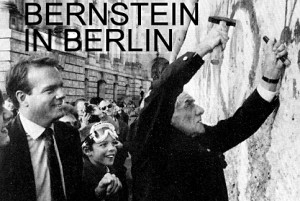 Beethoven in general and the 9th Symphony in particular are German favorites for important and grand occasions. Twenty five years ago, when the Berlin Wall came down, maestro Leonard Bernstein came to this city at Christmas time to conduct the Berlin Philharmonic playing the 9th Symphony in two concerts for East Germans who did not generally have the option of crossing the Berlin Wall to West Berlin (just steps from the Brandenburg Gate) to hear the orchestra.
Beethoven in general and the 9th Symphony in particular are German favorites for important and grand occasions. Twenty five years ago, when the Berlin Wall came down, maestro Leonard Bernstein came to this city at Christmas time to conduct the Berlin Philharmonic playing the 9th Symphony in two concerts for East Germans who did not generally have the option of crossing the Berlin Wall to West Berlin (just steps from the Brandenburg Gate) to hear the orchestra.
(Just 3 days after the opening of the Wall, maestro Daniel Barenboim had conducted a free concert for East Germans in the same hall, also featuring Beethoven: his 7th Symphony and his first piano concerto, with Barenboim playing the piano.) On Dec. 23, 1989 Bernstein conducted Beethoven’s 9th in the West Berlin Philharmonic hall, and on Christmas day he conducted the piece in the main concert hall in East Berlin (then called the Schauspielhaus, now called the Konzerthaus). Both times, huge TV screens were set up outside for all the people who couldn’t get tickets to sit inside. Bernstein changed the words of the famous fourth movement set to and named for the German poet Friedrich Schiller’s “Ode to Joy” (“An der Freude”) to “Ode to Freedom” (“An der Freiheit”) for the performances.
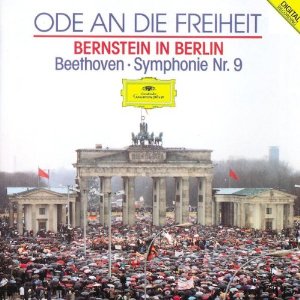
Simon Rattle kept the “joy” (“Freude”) in the lyrics tonight, and everyone in the sold-out hall certainly felt that joy: joy for this beautiful piece of music, joy to hear the world-renowned orchestra, and joy to be in reunited Berlin. The choir sat quietly on the stage with the soloists for the first three instrumental movements of the piece and then joined in for the “Ode to Joy.” I couldn’t help but think of the East Germans on the streets 25 years ago raising their voices en masse to call for change, for freedom and democracy. The 4th movement started quietly and slowly with the basses playing the melody. They were then joined by violas and violins, woodwinds, brass, and others, building and building, growing louder and louder, until finally everyone joined in playing while the chorus sang, “All men will be brothers” (“Alle Menschen werden Brueder”). The piece seems to ascend to the heavens with joy and gratitude. It is easy to understand why East Germans were moved to tears 25 years ago listening to this music. I can only hope that somehow, somewhere Beethoven knows that this magnificent piece of music he composed between 1822 and 1824 as he became completely deaf still moves so many people almost 200 years later.
 The program notes tonight (by Volker Tarnow) tell us that by the end of World War II, parts of the autographed copy of the 9th Symphony were located in eastern and western Germany and in Poland. In 1977, Poland gave its part to East Germany. Beethoven’s original work was now divided by the Berlin Wall, with part in East Berlin and part in West Berlin. Only with German reunification was the entire piece back under the same roof in united Berlin.
The program notes tonight (by Volker Tarnow) tell us that by the end of World War II, parts of the autographed copy of the 9th Symphony were located in eastern and western Germany and in Poland. In 1977, Poland gave its part to East Germany. Beethoven’s original work was now divided by the Berlin Wall, with part in East Berlin and part in West Berlin. Only with German reunification was the entire piece back under the same roof in united Berlin.
This Sunday evening, Nov. 9, at the Brandenburg Gate, the Berlin Staatskapelle orchestra under Barenboim will play the “Ode to Joy” for the final moment of the official festivities when 8,000 illuminated balloons (which are being installed along 15 kilometers of the former border as I write) will be released into the night sky, dissolving the Berlin Wall yet again.
–HMH
—————————————————————-
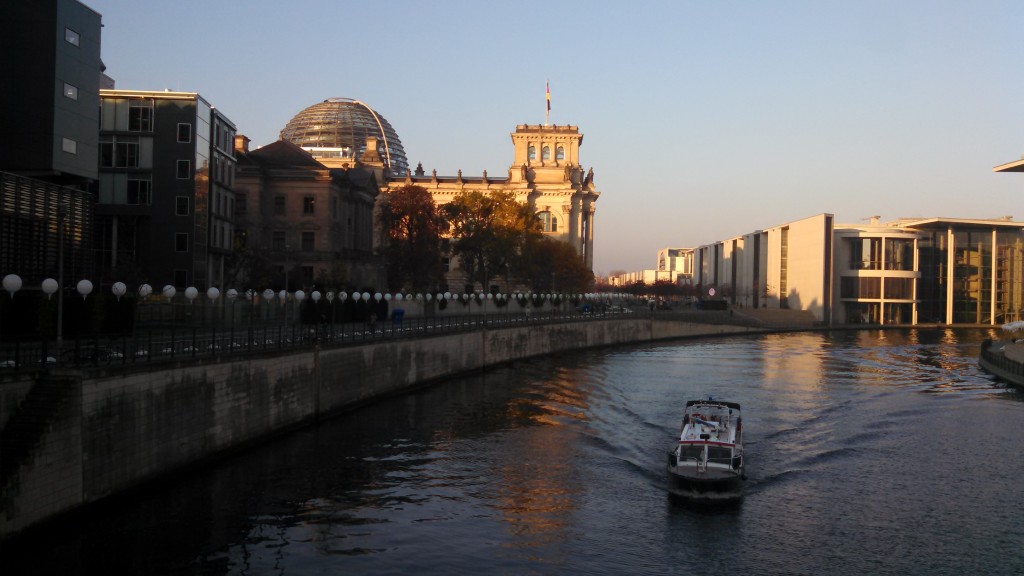
November 7, 2014 — Bundestag Ceremony
What a glorious day it was here in Berlin today. Brilliant blue sky, crisp fall air, and 8,000 brilliant white balloons along the former path of Wall in the center of Berlin. I started the day with the official Bundestag ceremony commemorating the 25th anniversary, in the historic Reichstag building. An old friend who is a member of parliament got me a ticket to attend the ceremony.
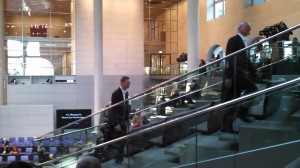 Ushers in tails and white bow ties took us to our seats. I haven´t ever been to a formal ceremony in the Capitol, but I don´t think we have ushers in tails there! The ushers kept telling the guests up in the balcony watching the proceedings not to take pictures, but we kept taking out our cameras and cell phones when they walked away! To my great frustration, I was told I had to check my purse with my pen and note pad and everything else upon arrival. They said that since it was a plenary session, no notes were allowed. Of course the media was everywhere! Somehow I kept my cell phone and a pen in my pocket. And the “reserved” signs on our seats served very well as note cards! 🙂
Ushers in tails and white bow ties took us to our seats. I haven´t ever been to a formal ceremony in the Capitol, but I don´t think we have ushers in tails there! The ushers kept telling the guests up in the balcony watching the proceedings not to take pictures, but we kept taking out our cameras and cell phones when they walked away! To my great frustration, I was told I had to check my purse with my pen and note pad and everything else upon arrival. They said that since it was a plenary session, no notes were allowed. Of course the media was everywhere! Somehow I kept my cell phone and a pen in my pocket. And the “reserved” signs on our seats served very well as note cards! 🙂
After Bundestag, President Norbert Lammert gave his opening speech, the famous East German dissident singer-song writer, Wolf Biermann came to the microphone with his guitar. His communist, Jewish father had been killed in Ausschwitz, and Biermann moved from West Germany to East Germany after the war to try to continue his father´s commitment to communism. Instead, he felt constrained by communism and began to sing about all the problems with the system. He was the most famous East German dissident artist, or infamous as far as the Stasi was concerned. Finally, when he was giving a concert in West Germany in 1976, the East German authorities announced that he was not allowed to return. That was a shock for everyone, including a young Angela Merkel.
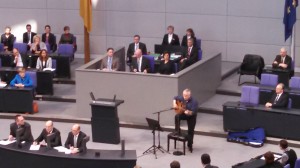
Wolf Biermann singing
Biermann came out fighting today, looking over at the area where the party of the former communists, the Left Party (die Linke) were sitting. Although he said that he wasn`t going to talk about them, since they had already been punished by history and were the miserable remains of a fallen regime, he couldn´t seem to stop criticizing them. Finally he said that he would sing a song, “Ermütung,” about the things that inspired people in East German, including in prison, to gather up their strength and fight for justice, freedom and human rights. There was much applause after he finished and the chancellor immediately went over to shake his hand. President Lammert also announced that Biermann and his wife were celebrating their 25th anniversary this weekend and congratulated them.
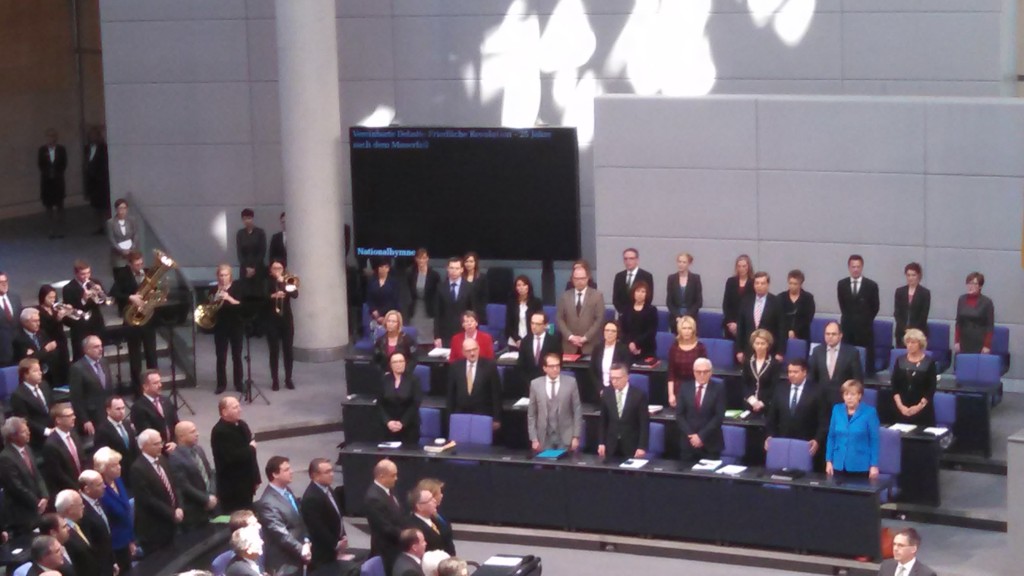
Chancellor Merkel in blue jacket
Speakers from each of the parties followed Biermann´s appearance, some of whom had been Bundestag members in 1989 and remembered how it felt then to learn about the opening of the Berlin Wall. Although there was much grumbling in the hall when Gregor Gysi of the Linke party spoke, he did say that East Germany had been a dictatorship and a state without the rule of law (even if he had been a lawyer there). There was also a short film made for the occasion featuring interviews with former East German dissidents, which everyone watched. At the end of the proceedings, everyone stood and sang the national anthem before going on to various receptions or outside to enjoy the fabulous weather and the balloons.
The Wall had in fact been right outside of the Reichstag, so the building as used only for small exhibits during the Cold War. At the end of the 1990s, the united German parliament moved into the newly restored Reichstag with a new glass dome on top. During the ceremony, I could see visitors up on top looking down, and at one point the sun was streaming down onto my head somewhat blinding my view!
 Before the session, I had strolled along the river looking at the balloons and Reichstag dome gleaming in the sun. Afterwards, I walked 1 block over to the Brandenburg Gate and the American embassy. Of course, the embassy with its technical equipment on the roof for listening in on the Germans and others has been incredibly controversial here. I was greeted there by several German employees and wondered whether their friends and families were critical of them for working there knowing about the NSA´s activities, including listening in on the chancellor´s cell phone. One young German employee said that she has gotten lots of critical questions from her friend and family.
Before the session, I had strolled along the river looking at the balloons and Reichstag dome gleaming in the sun. Afterwards, I walked 1 block over to the Brandenburg Gate and the American embassy. Of course, the embassy with its technical equipment on the roof for listening in on the Germans and others has been incredibly controversial here. I was greeted there by several German employees and wondered whether their friends and families were critical of them for working there knowing about the NSA´s activities, including listening in on the chancellor´s cell phone. One young German employee said that she has gotten lots of critical questions from her friend and family.
The embassy conducted a video interview with me in front of a piece of Wall they have in a courtyard there. They will post it soon. They asked me to talk about my own experience flying to Berlin on Nov. 9, 1989 and being there for 10 wonderful days starting on the morning of Nov. 19.
The city is packed with people and cars. The German train employees decided to go on strike starting yesterday. People have been very angry about their choice of timing, just as Berlin celebrates the 25th anniversary of the fall of the Wall. So there are more cars than usual precisely at a time when many streets are closed due to the 8,000 balloons along the former border. Apparently late today, the German train management came to some sort of agreement and the trains will run again starting tomorrow. This will help the estimated 500,000 people get here for the highpoint of the celebrations on Sunday.
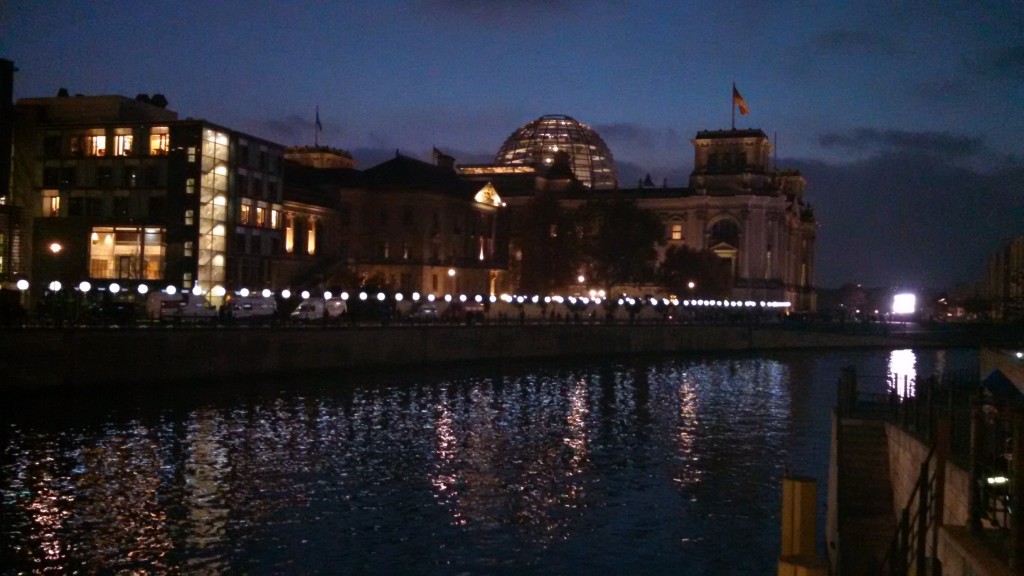
Border of Light/Lichtgrenze
Tonight at 5pm (when it was already almost completely dark here), the mayor officially opened the Border of Light in the stretch along the Spree River and the Reichstag. I stood in a crowd of media people and others clapping as the final lights in the balloons went on. And successfully! I have known the mayor and the organizers of this Border of Light for several years and interviewed them all previously. So today I received a happy surprise at my hotel: an invitation to join them all on a boat trip tonight along the Spree River to see the balloons. And with a full moon and clear sky no less! Wow!
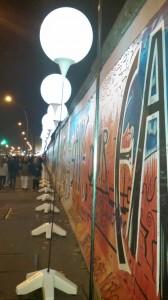
We started at the Moltke Bridge by the chancellery, went past the Reichstag, around the Museum Island, through the locks and along the East Side Gallery, under the Oberbaumbrücke and back to dock at East Side Gallery. We were served sparkling wine, warm mulled wine, currywurst, chicken on skewers and other nice things whether we sat inside the boat (which I did at first) or outside (which I did for most of the time). Moving along the river, we took in the magic of the evening with the full moon above and illuminated ballons and city lights below. I toasted many times with people I knew and people I didn´t know! We told each other our stories connected to the Wall.
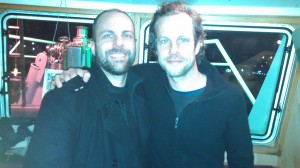
Marc and Christopher Bauder
I talked with Marc and Christopher Bauder, the incredibly down-to-earth, nice brothers who had the inspiration for the Border of Light and whom I interviewed this summer. Christopher has long worked with lights and balloons in his artistic installations. And Marc has made several films dealing with the history and suffering of people in communist East Germany. On big outdoor screens set up in 8-10 famous places along the Border of Light, a film Marc made for this weekend is shown. After working in about 30 archives, Marc compiled historic footage of interviews with people between 1961 and 1989 about the Wall. He divides them into topics like “dreams,” “escapes,” and “life with the Wall.” At every screen we passed, hundreds of people were gathered outside watching.
When we got off the boat at the end of the trip at the East Side Gallery, I stood in the crowd watching the film and Marc walked by. He stopped to talk, and I was happy for the chance to give him a congratulatory hug. What a feeling it must be for these two brothers to have created this event and to see hundreds and thousands of people enjoying it and learning about it. I know they are also very relieved that it has all worked without any major problems!
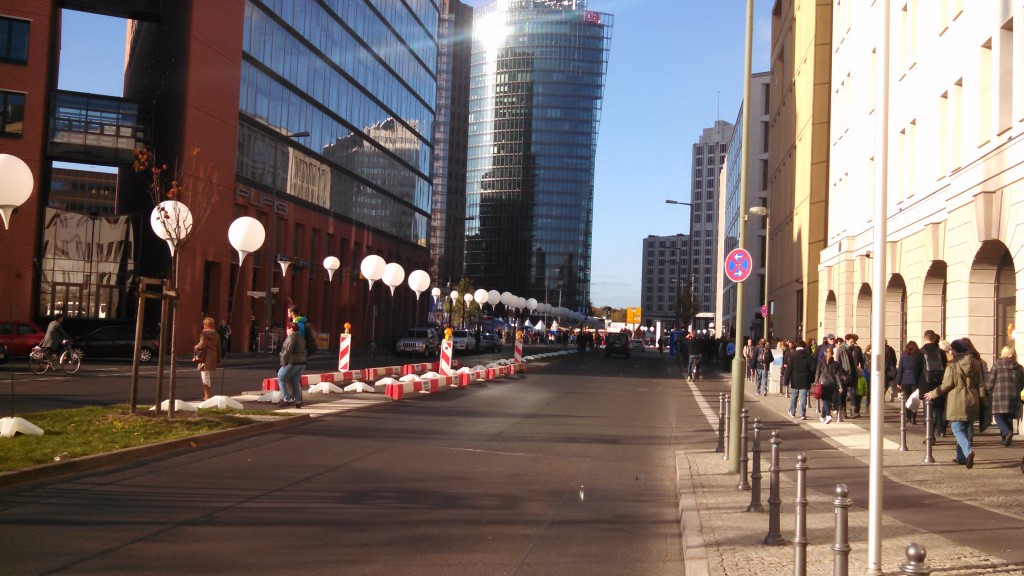
The Bauder brothers are from the West. Tom Sello, however, who helped create the 100 historical information points along the border with the 8,000 balloons, was in the opposition in East Germany. He was on the boat too with his wife and niece and friends and was happy to celebrate after working so hard for months and months.
On the way back to my hotel from the East Side Gallery, my taxi driver shared his story from 25 years ago. He was a construction worker in East Berlin. He didn´t follow the news on the night of Nov. 9 and only at work on Nov. 10 did he hear the Wall had fallen. So 20 construction guys piled into a truck and drove to West Berlin. At a certain point (after hours of looking around and drinking and celebrating), he called his poor wife back at home in East Berlin, who was really wondering where the heck he was. Needless to say, she wasn`t too happy he had gone without her! He returned home late that night and took her to West Berlin the next day.
–HMH
—————————————————————
November 8, 2014 — Merkel, Biermann, Applebaum & Sikorski
It was another gorgeous, sunny day here in Berlin. And it was even sunnier with the news that the train strike would end today. Stores with sales of 25% off to celebrate the 25th anniversary also help put people in a good mood!
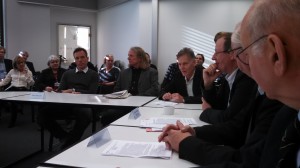
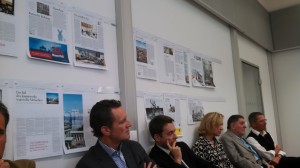 My day started with a fascinating meeting at one of Berlin’s most famous newspapers, the Tagesspiegel (Daily Mirror). I was invited months ago to contribute an article to the special Sunday edition on the fall of the Wall on November 9. All of the contributors located in Berlin were invited to come discuss the issue with the editors and each other for a couple of hours.
My day started with a fascinating meeting at one of Berlin’s most famous newspapers, the Tagesspiegel (Daily Mirror). I was invited months ago to contribute an article to the special Sunday edition on the fall of the Wall on November 9. All of the contributors located in Berlin were invited to come discuss the issue with the editors and each other for a couple of hours.
Among us were two former mayors of West Berlin and United Berlin (Diepgen and Momper), the Federal Minister for Family, Senior Citizens, Women and Youth (Schwesig), the head of the Stasi Records Authority (Jahn), and others from politics, culture and finance. The artist Christo and the film maker Wim Wenders also contributed articles but could not be there today. We each gave a short summary of our article and then discussed together ideas for the chief editor’s lead story. A hot topic for discussion was whether Wolf Biermann went too far yesterday attacking the Left party at the Bundestag. Some people felt he was rehashing old debates that are of no interest to people now. Others felt that there still has not been enough done to make up for (or try to make up for) the suffering some people endured in East Germany.
At the end of the group meeting, the editors asked whether someone would volunteer to write a short commentary relevant to Nov. 9 in an as yet unfilled space on the opinion page. No one volunteered, including me! But afterwards, one of them said: “you are a historian, you know our history; you write something!” I said, “well, okay, if I can do it right now on one of your computers before I leave for my next meeting.” And sure, enough, that’s what happened! I wrote half in English, half in German. We discussed my ideas, and then they translated my short 5-line commentary on Germans dealing with their history. It was great fun, working alongside the journalists at my favorite Berlin newspaper.
I then needed a taxi to take me to the Brandenburg Gate for an interview with a group called “Memory of the Nation,” similar to the US project with the Library of Congress where Americans are recorded telling stories of their lives. Someone had told this German group about my incredible experience being on a plane headed to Berlin when the Wall came down and arriving here the next day for a 10-day visit.


On the way to the Brandenburg Gate, my Turkish taxi driver drove us along the path of balloons through Potsdamer Platz. He himself was so excited that he recorded the view in front of him with his cell phone while driving slowly! He loved the celebration and I was happy to have such a fun taxi driver. I took a picture of him filming with his cell phone while driving! He kept saying, “I hope the police won’t come.” They didn’t!
Potsdamer Platz and the area around the Brandenburg Gate were packed with people out walking around to see Christopher Bauder’s balloons and watching Marc Bauder’s moving film. I walked past the Holocaust Memorial and the US embassy and through the Brandenburg Gate into Pariser Platz on the eastern side of the Gate, which was even more packed with people.
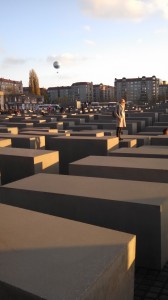
All the main German organizations that have to do with history and confronting German history have tents there giving out free materials to people. There is also a small outdoor exhibit on the century of German history between 1914 and 2014 as well as on the German attack on Poland 75 years ago in 1939 which began the Second World War. The Germans really put the dark parts of their history right out there for all to see, in German and in English. After I sat in a temporary studio in a (mostly!) sound-proof truck in Pariser Platz for the interview with “Memory of the Nation,” I stopped by to see a friend working at one of the tents there. He told something about his own East German history that has made it hard for me to think of anything else ever since.
I asked him whether he had written anything about the anniversary of the fall of the Wall. “No, Hope, I haven’t written any articles, but there is an article written about me that will soon appear. I have told a journalist my own history of where I was 25 years ago.”
Then he turned around and pointed to the middle of the square at the Brandenburg Gate.
“I was standing here 25 years ago on the night of November 9 in the East German army.”
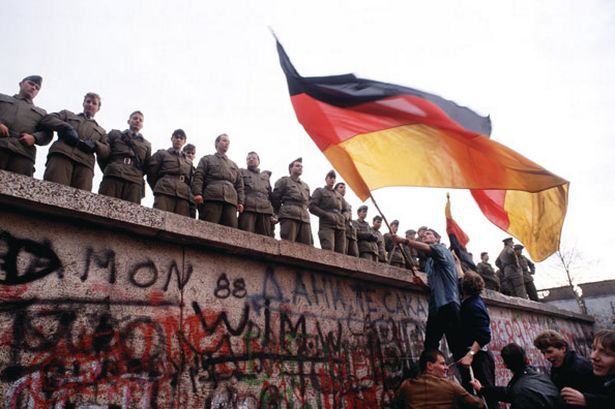
What? This was the last thing I ever expected this smart, nice, warm-hearted person to tell me. I have many pictures from my time in Berlin in November 1989. My pictures include some with East German soldiers standing on top of the Wall at the Brandenburg Gate. Was he one of them? I don’t know.
“I was standing here 25 years ago on the night of November 9 in the East German army.”
What? This was the last thing I ever expected this smart, nice, warm-hearted person to tell me. I have many pictures from my time in Berlin in November 1989. My pictures include some with East German soldiers standing on top of the Wall at the Brandenburg Gate. Was he one of them? I don’t know.
“I wanted to go to the university, and you weren’t allowed to attend university in East Germany if you refused to do compulsory military service. I started my service in the army on November 1, and on November 9, I was stationed at the Brandenburg Gate.”
Not being from Berlin, he was able to be stationed at the Berlin Wall. He told me that he was in the army until the compulsory military service obligation was lifted in a couple of months, and then he did some sort of social work instead. And then of course East Germany ceased to exist.
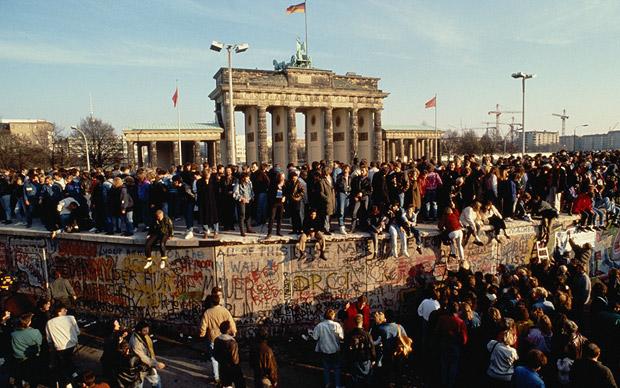
Crowds at the Brandenburg Gate bear witness to the Fall of the Berlin Wall. Picture: GETTY
But, my god, for 25 years, he must have always been thinking about this and wondering how much to tell people and when. Meeting with a young journalist from the west a few days ago, he must have somehow liked the guy and decided now was the time to tell his story. My friend told me that he kept feeling that since he was arguing all the time in his scholarly work and his job that people must come to terms with the past, it wasn’t fair if he didn’t also talk about his own past in East Germany.
He also said that he is so sick of all the stories in Germany now of “heroes” in East Germany and how they created the “Peaceful Revolution” that brought down the Wall. He said it’s like Disneyland with all this talk of heroes all the time. (And he’s right; this is something I am writing about in my book on how Germany looks back on the history of the Berlin Wall.) He decided to play a role and step forward and tell his story. Life was complicated. East Germany wasn’t comprised only of people who were either heroes who protested and were imprisoned or people who were cold, hard communists. But the discussions in Germany about the East German past are very emotional and polarized and it’s not easy to try to talk about shades of gray instead of black and white.
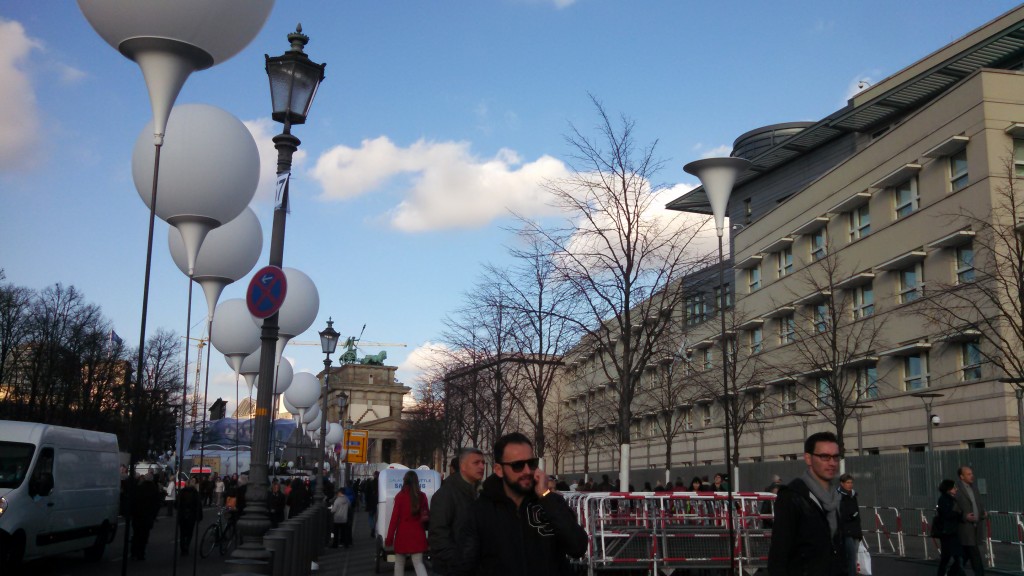
I had only 10 minutes to stand there talking to my friend before I had to go meet some students from George Washington University studying in Berlin. This was nowhere near enough time. I have so many questions. And I am worried about how some people may respond to his “outing” as someone who guarded the border in Berlin, albeit for a short time and largely after the Wall ceased to be the deadly barrier it had long been.
I left him to meet the students and tell them about the history of the Berlin Wall while we walked around the Brandenburg Gate and looked at the balloons. We will meet again Sunday tonight for the official part of the Border of Light celebration when we release the balloons into the sky.
There were at least two (and probably many more) great events with well-known people going on in this city tonight. One of them I had a ticket to and the other I didn’t. The one I did not have an invitation to was a gala dinner put on by Cinemas for Peace and Mikhail Gorbachev’s New Policy Forum at the famous Hotel Adlon near the Brandenburg Gate. This featured politicians, policy analysts, and Hollywood stars (including Leonardo DiCaprio, Stephen Spielberg and Tom Hanks) participating in a conference about the world 25 years after the fall of the Wall. At the gala, Gorbachev was awarded the “man of the century prize.” And apparently, DiCaprio had a video message instead of being there in person.
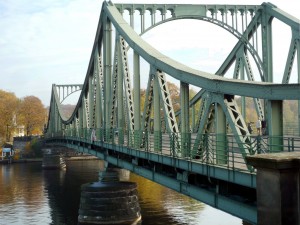
Glienke Bridge
It seems Spielberg and Hanks are in town filming for a movie about the famous 1962 spy exchange at the Glienicke Bridge of Francis Gary Powers (the American whose CIA U-2 over the Soviet Union was shot down by the Soviets in 1960 and he was put on trial) for Rudolf Abel (a Soviet spy) between West Berlin and Potsdam, East Germany.

PHOTO: Spy swap between Francis Gary Powers and master Soviet spy Rudolph Abel.
The event I did have a ticket for was a concert with Wolf Biermann, his wife Pamela (who has a gorgeous voice) and the Zentralquartett (a play on the words Central Committee, which was one of the top ruling bodies of the communist party in East Germany) at the famous Berliner Ensemble where Berthold Brecht used to be. A friend of mine who is close friends with Biermann had gotten me 2 tickets to this long-ago sold out concert, which Chancellor Merkel also attended as did the President of the Bundestag, Norbert Lammert, and the President of the Polish Sejm, Radek Sikorski and his wife the Pulitzer-prize winning historian Anne Applebaum.
Anne happens to be a friend of mine, and I had no idea she and Radek would be in Berlin and at Biermann’s concert. I found myself in the quite extraordinary position in the foyer of the theater translating for a few minutes from German to English as Biermann told Anne and Radek about his father and other relatives killed in the Holocaust for being Jewish and communist. Eventually, someone came to get Biermann to start the concert, and we took our seats—they were in the front row, I was toward the back!
After Biermann’s vigorous critique of the Left party in the Bundestag yesterday, we were all curious what would happen tonight. But he was in his element with so many people in the audience who were inspired by his music in East Germany and excited for the relatively rare opportunity to hear him perform again. And of course he had the most high-level introduction possible when Chancellor Merkel (in a beautiful bright pink jacket) walked up to the stage and spoke about how important Biermann was in East Germany and how music there was not just art but was also very political.
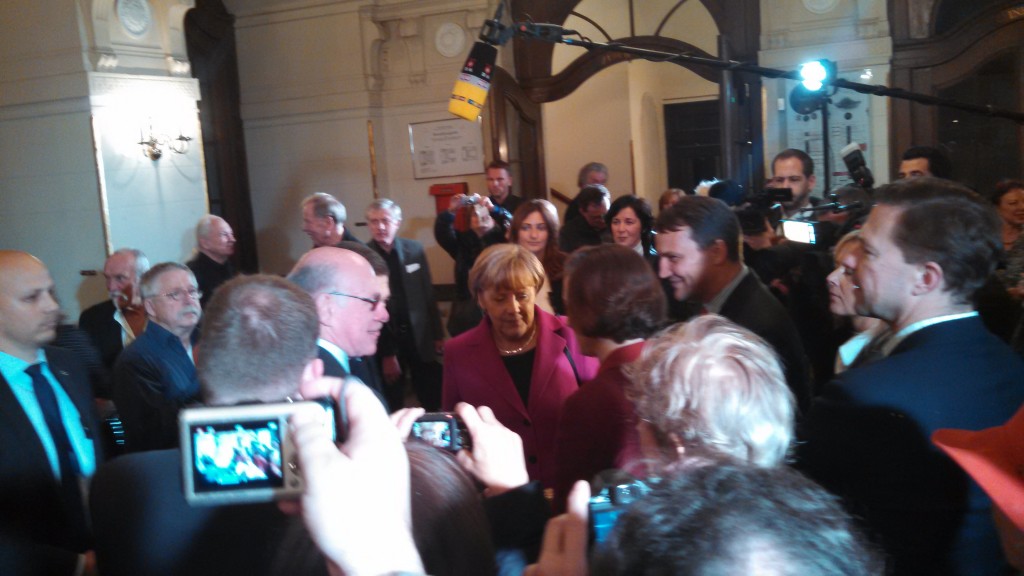

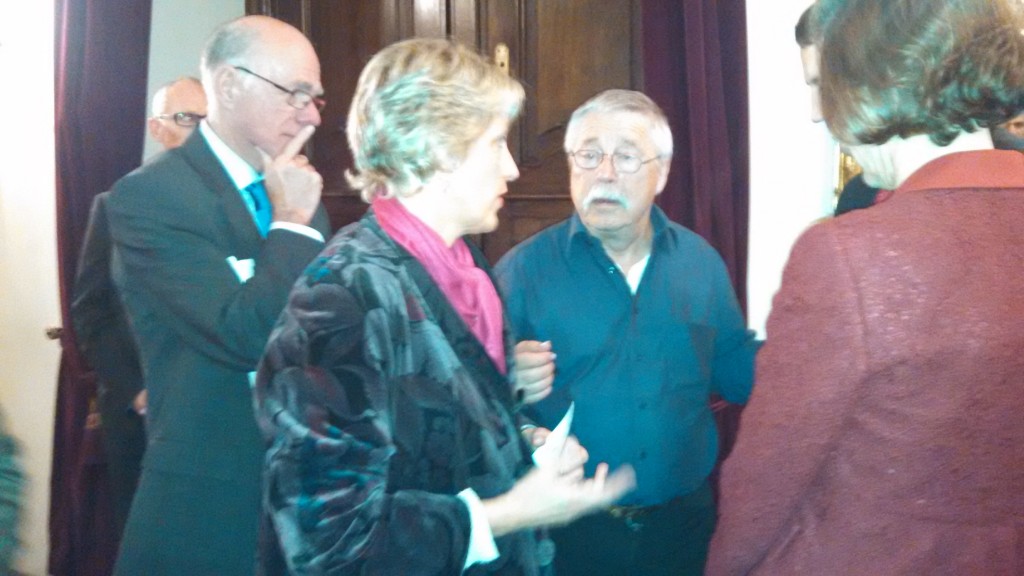
Biermann’s songs were so openly critical of the East German leadership and communism, which is why he was totally banned from any performing or publishing in 1966 when he was 30. So he sang about that. And he sang about the Stasi (in his famous “Stasi Ballade”) and how they probably sang his songs even while in bed, since they eavesdropped on him 24 hours a day. He again sang another famous song, “Ermutigung,” (translated as “cheering up” or “encouragement”) which he performed yesterday in the Bundestag. With lines like, “Don’t let yourself be hardened in these hard times . . . Don’t let yourself be scared in these scary times. . . . We won’t be silenced in this time of silence,” this song helped East German political prisoners who often sang it to themselves quietly, sometimes having no idea who actually wrote it, since it was distributed by hand and by word of mouth.
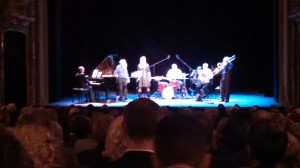
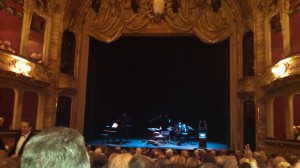
Needless to say, at the end of the concert, people kept applauding, so Biermann and the group came back a couple of times to sing. The final number was just him and the drummer, a guy called Baby. Biermann talked about how in East Germany the two of them had wanted to record a song to be published in the West, but they didn’t want the Stasi guys surrounding Biermann’s house to know. So Baby showed up without any drums. “But he had his most important instrument; his hands,” as Biermann told us.
“We had to improvise. We found a big cookie tin, and Baby started rapping on that. And it worked. We recorded a song. Then everyone in the West thought it was so great and wanted to figure out how we did it. We had also just dropped some matchbox cars on the floor to create another sound, and they sort of had a lingering rattling effect. That’s all they were; matchbox cars. But everyone in the West kept trying to figure out how we engineered that sound! So you see . . . ” (and then he used an incredibly important and controversial expression to end the concert), “it wasn’t so bad in the German Democratic Republic!” This is what people who miss East Germany say or people who want to defend the lives they lived there; but particularly people in the Left party say this. Biermann was mocking them in a brilliant way to end a very special evening.
As my friend Ruth and I left the concert, we found (as is often the case in Berlin after 10pm) someone standing at the door selling tomorrow’s Tagesspiegel, the special edition for the 25th anniversary. I bought a copy. It was quite a day. And tomorrow will be too.
–HMH
—————————————————————
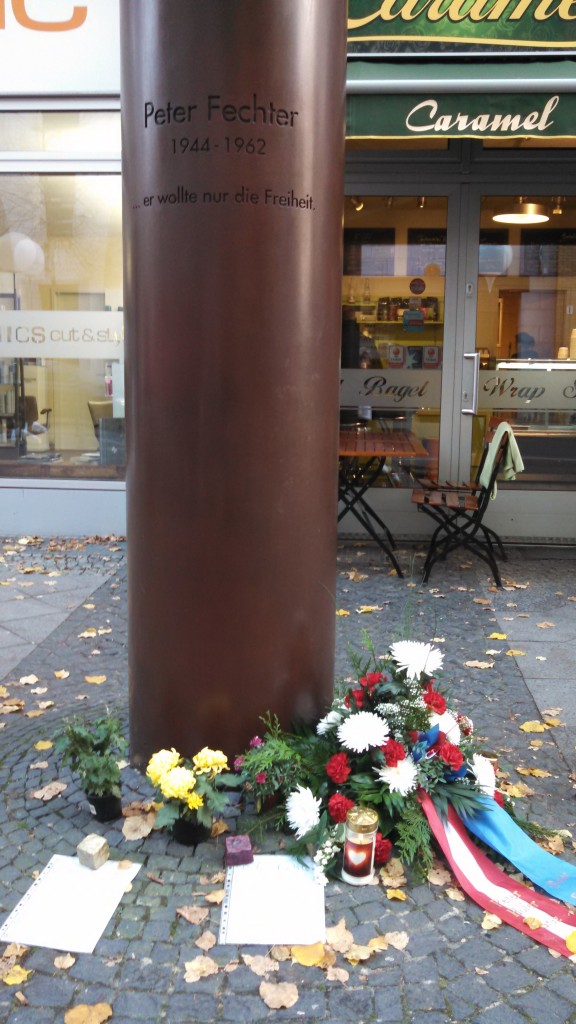
Peter Fechter Memorial
November 8, 2014 — Peter Fechter Memorial
A few days ago, I visited the memorial for Peter Fechter near Checkpoint Charlie. In Aug. 1962, a year after the building of the Berlin Wall, 18 year old Fechter tried to escape from East Berlin across the Wall. He had crossed the first wall and most of the death strip, but just when he reached the 2nd and final wall to get over to West Berlin, border guards shot him. He lay there bleeding and crying for help. The border guards stayed away, trying to hide from all the people watching from West Berlin (including people with video cameras and still cameras). The people on the western side of the Wall were too afraid to climb over it and trespass into East German territory. So everyone stood there watching while Peter Fechter’s cries for help grew weaker and weaker. And then they stopped. He was dead.
—————————————————————
Additional Photos:
Inside the Berlin Wall Memorial At the Berlin Wall Memorial for the press conference and opening of exhibit for advanced look before official opening.
The new exhibit on the Berlin Wall, 1961-1989:
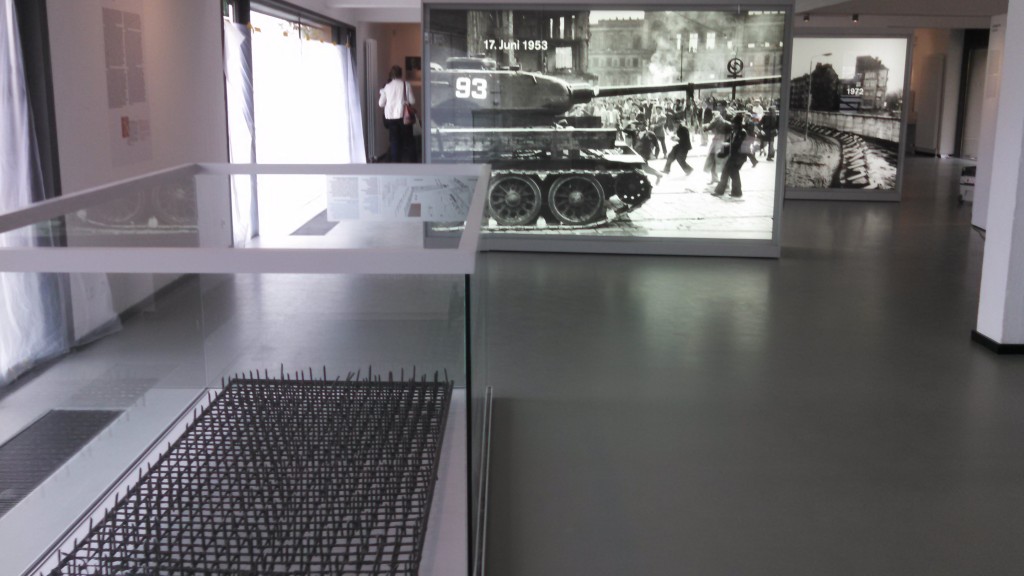
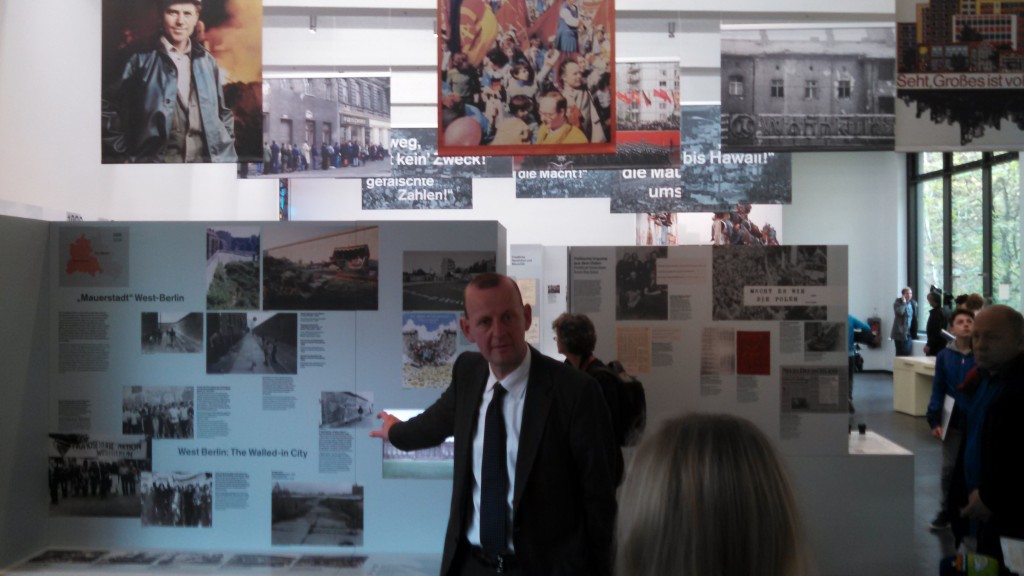
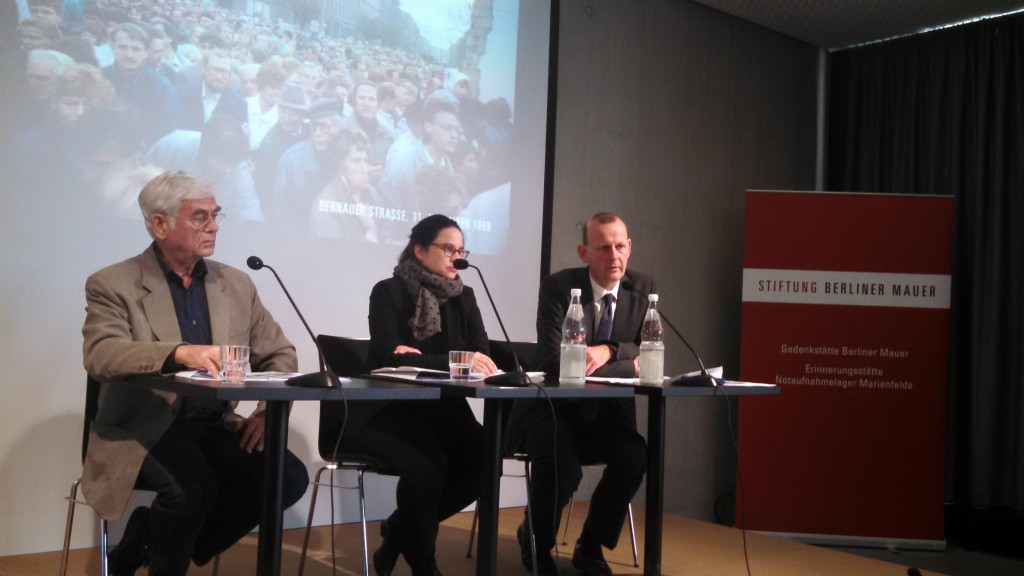
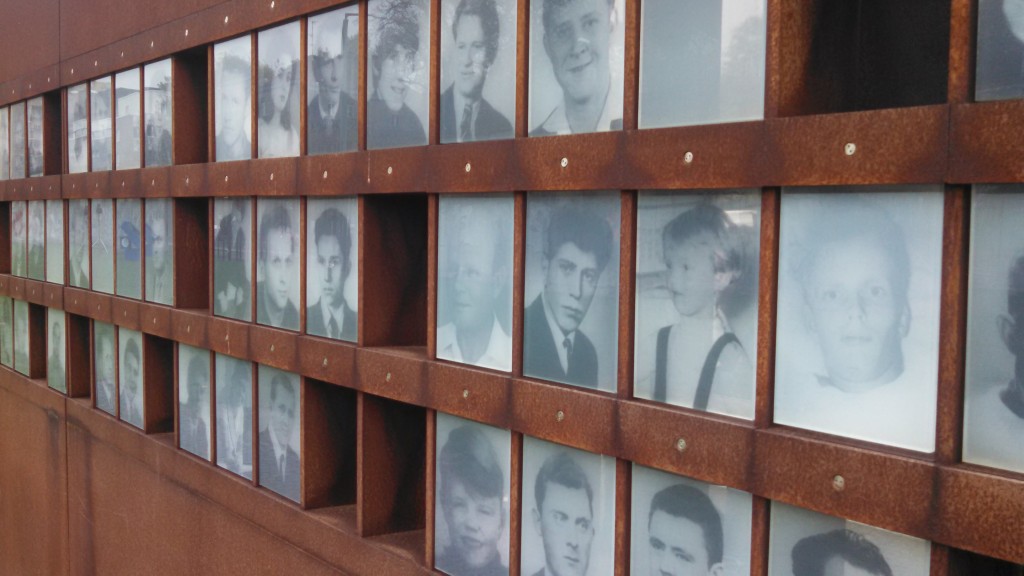
Window of Commemoration with pictures of some of the 138 people killed at the Wall
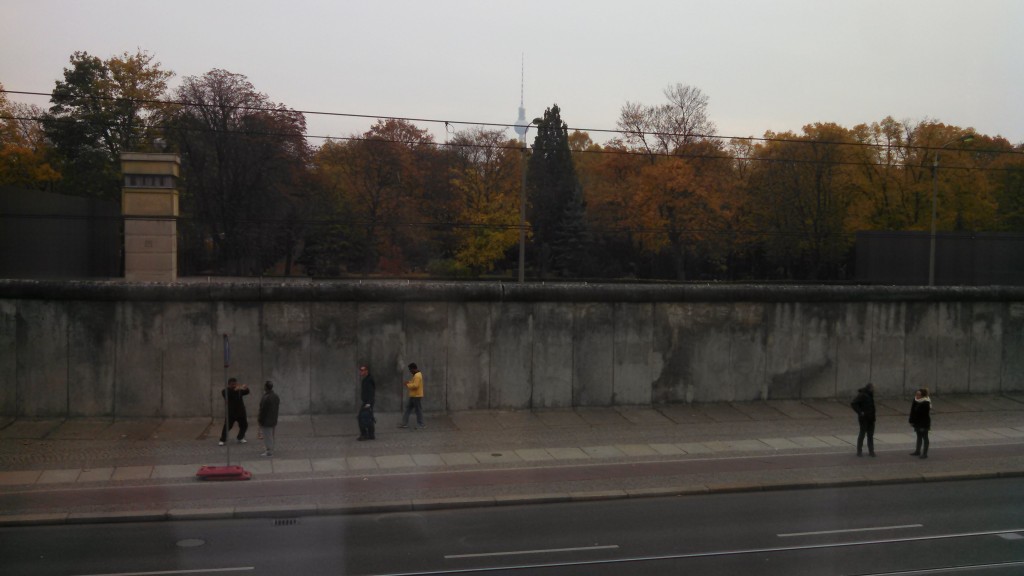
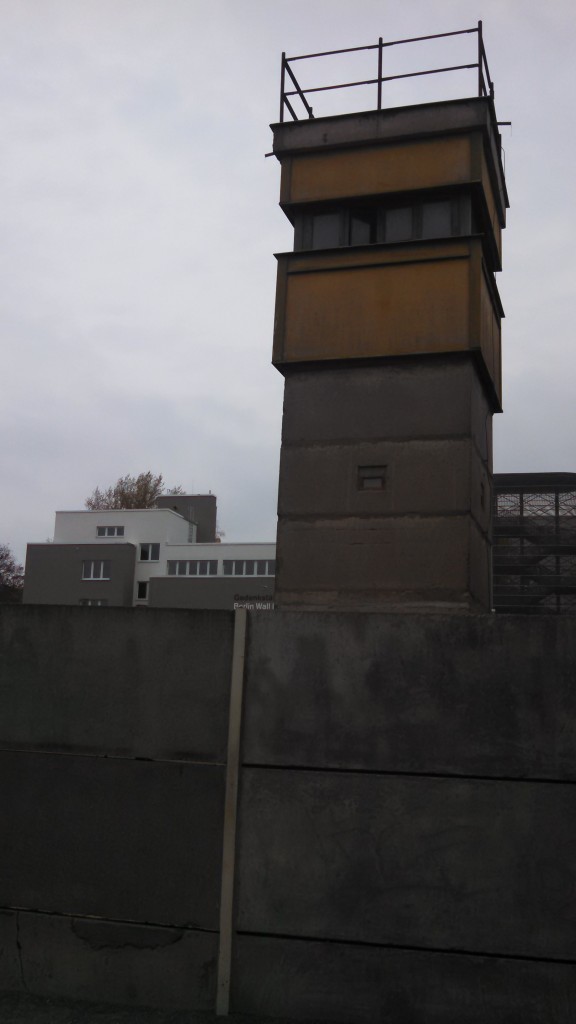
—————————————————————
November 9, 2014 — 25th Anniversary of the Fall of the Berlin Wall
These pictures show where the main events take place this morning at the Berlin Wall Memorial (all of which will be televised live on German public television for 2 hours). There will be a bugle call, then an ecumenical service in the Reconciliation Chapel there and the lighting of candles for victims of the Wall. Following this, Chancellor Merkel will give a speech to officially open the new permanent exhibit on the Berlin Wall there. I visited it all a few days ago and took these pictures.

Berlin Wall 2014

Hope M.Harrison Berlin Wall 2014

Former death strip with pictures of people killed at the Wall
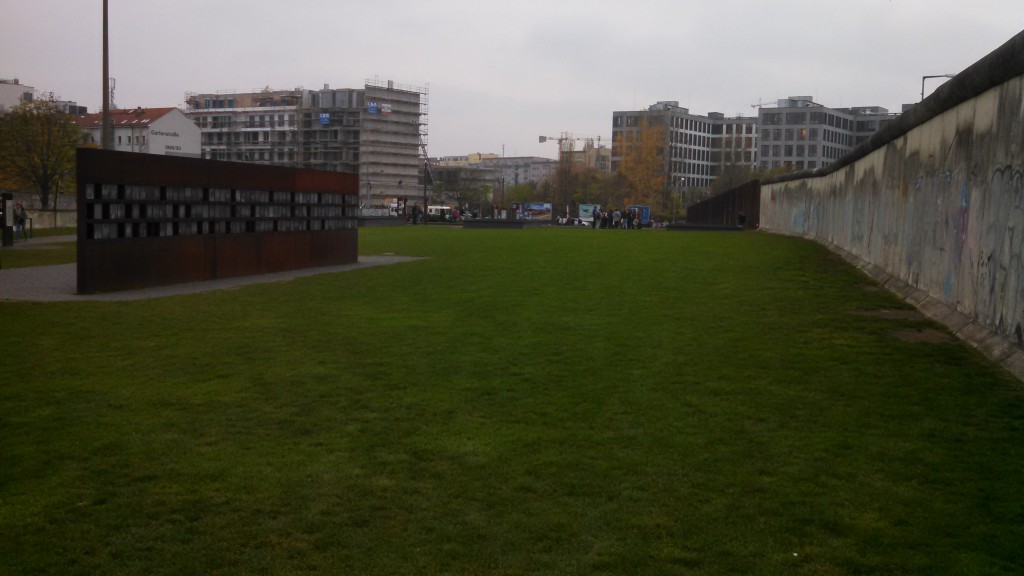
Berlin Wall Memorial
Sunday Nov. 9 is yet another beautiful day with a blue sky. The weather is cooperating very well!
My hotel is near Checkpoint Charlie, and the Wall ran behind the hotel. In the middle of the night I heard the unmistakable sound of balloons popping. I hope it wasn’t someone out there trying to ruin the Border of Lights.
This afternoon at 4pm in the Konzerthaus in the beautiful Gendarmenmarkt square, there will be an official ceremony with speakers including the mayor of Berlin, the president of the EU Parliament, and other prominent officials to commemorate the 25th anniversary.
PHOTOS — Ceremony at Berlin Wall Memorial on Sunday, November 9, 2014:
Former Hungarian Prime Minister Nemeth from 1989 and Chancellor Merkel and Mayor Wowereit. They put roses between gaps on the rear wall of the Berlin Wall. There was a speech by director of Berlin Wall Memorial Axel Klausmeier. Then Ecumenical Service for victims at the Wall in the Chapel of Reconciliation.
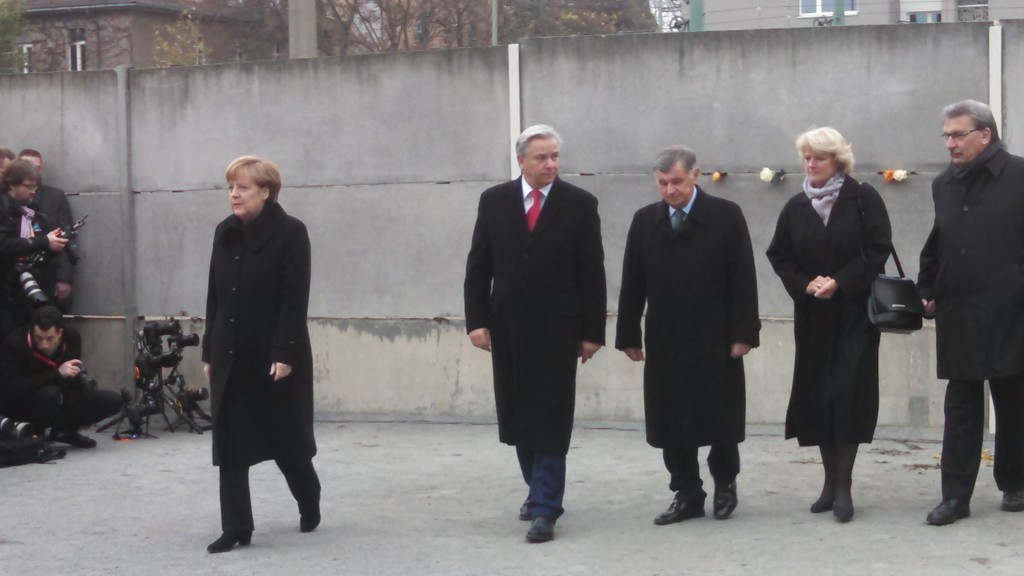
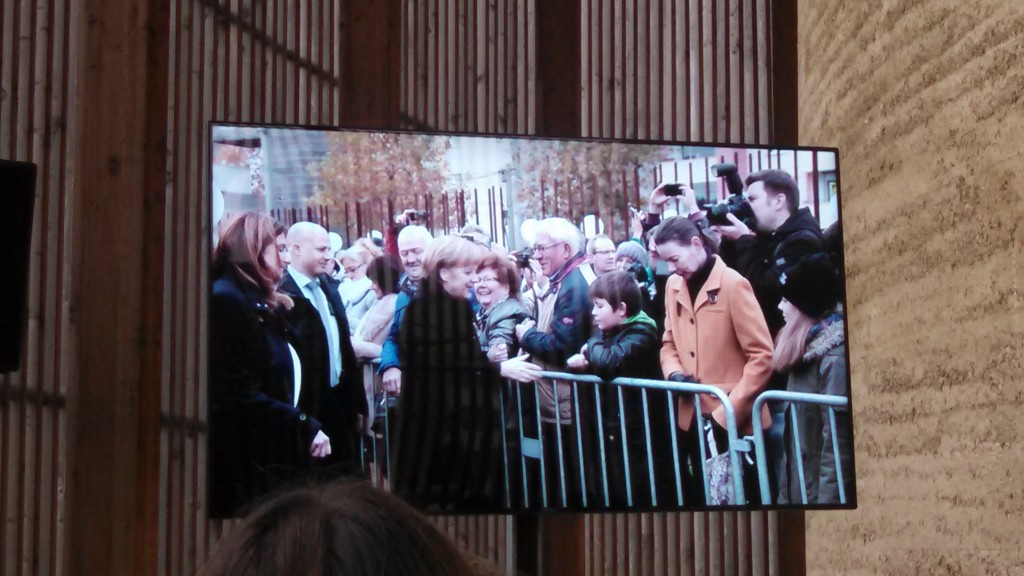
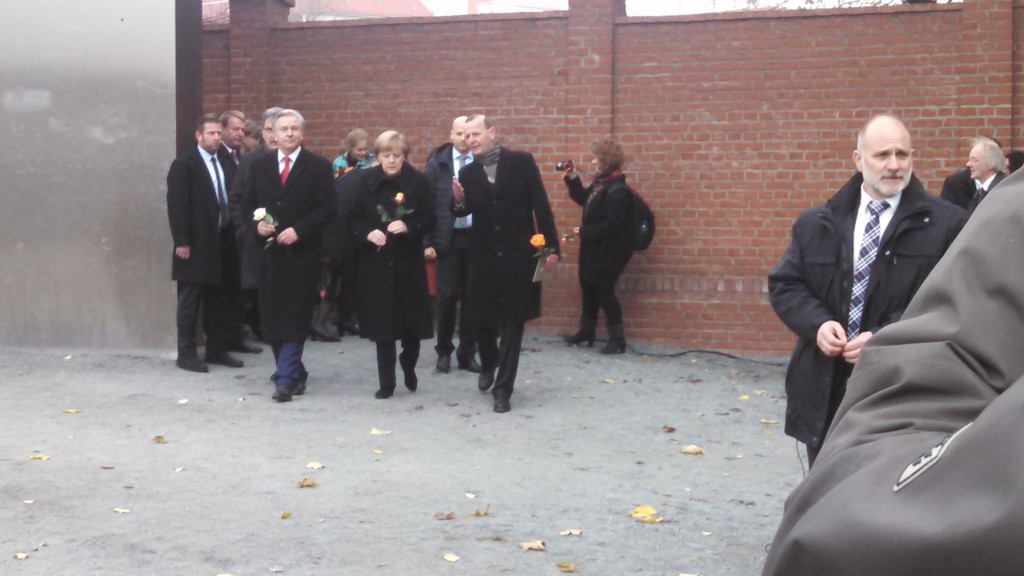
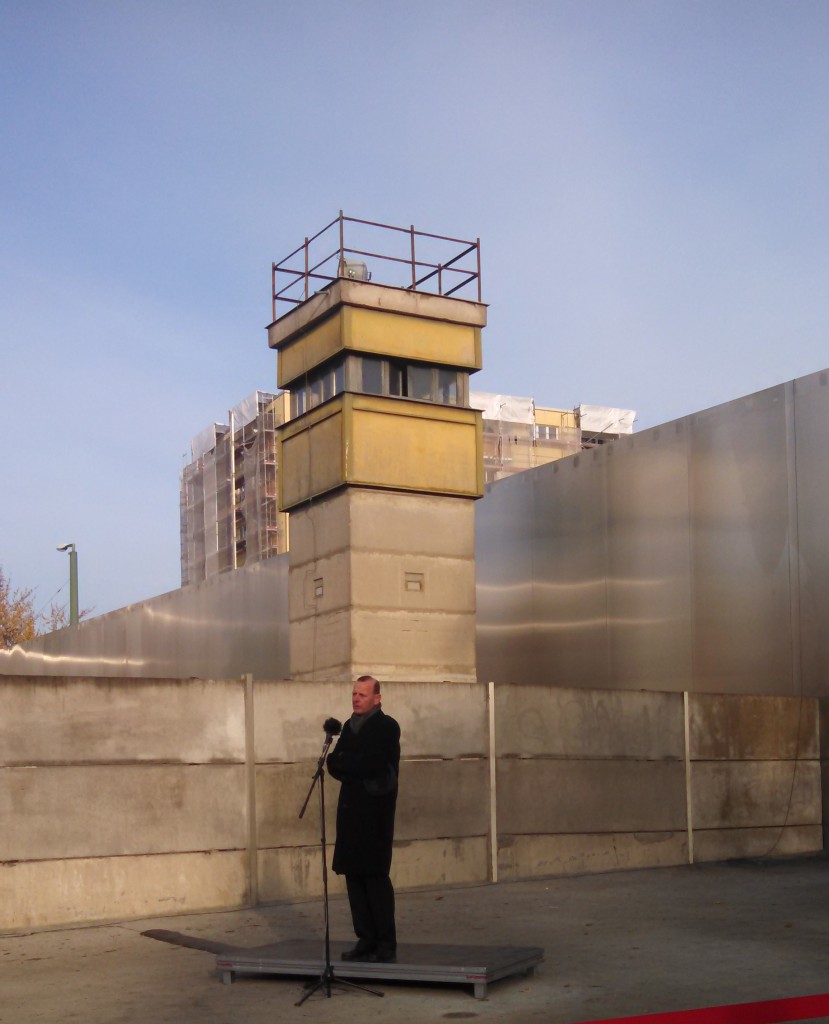
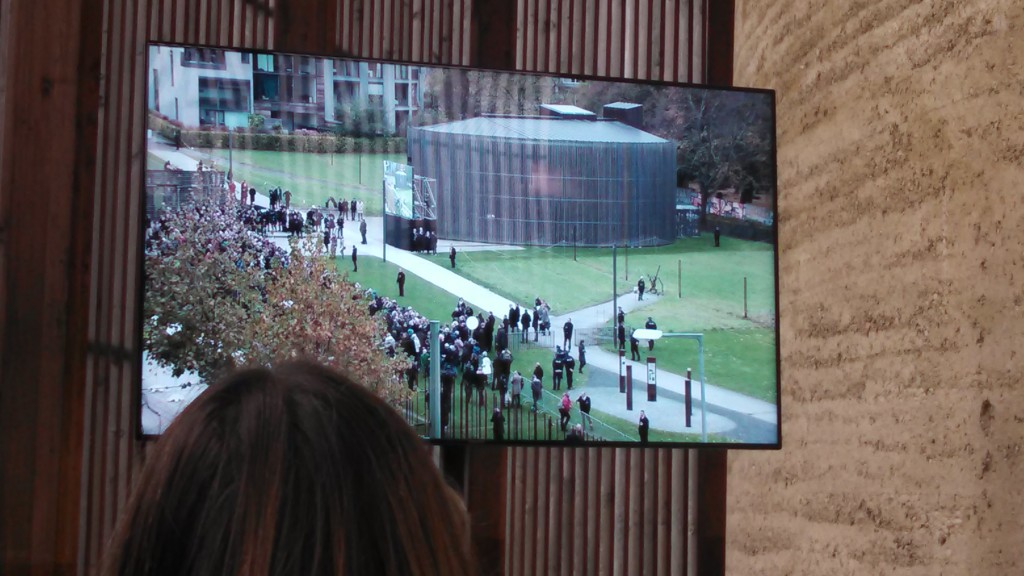
—————————————————————
PHOTOS — The official ceremony with Mayor Wowereit in the Konzerthaus
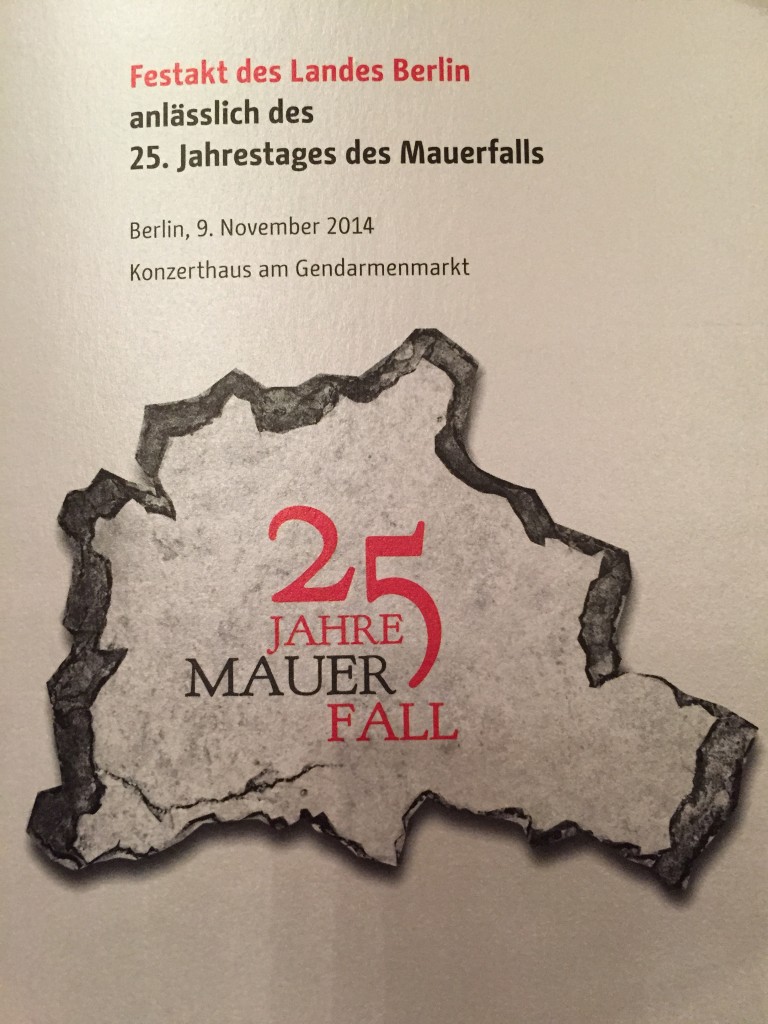
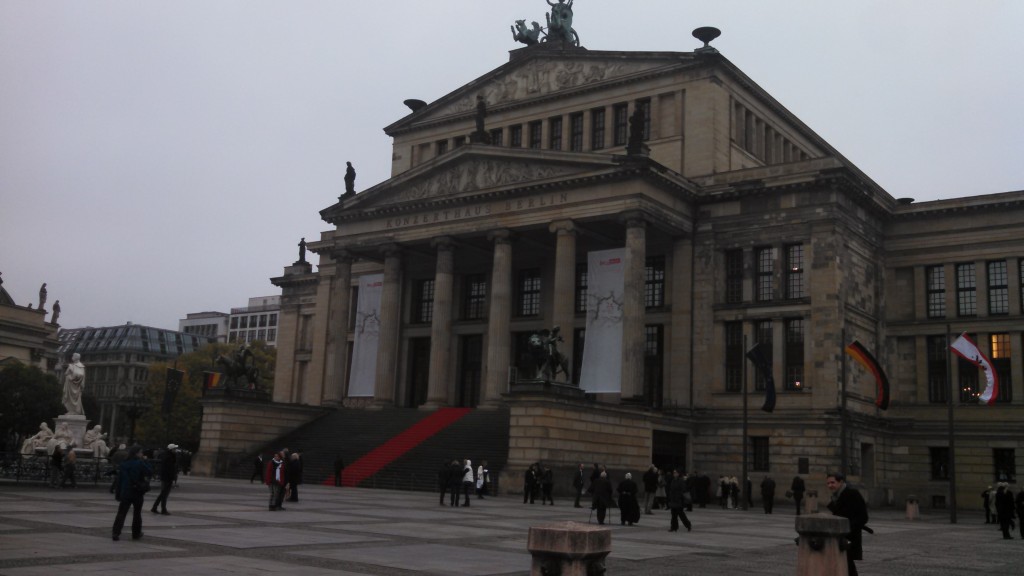
Konzerthaus

PHOTO: Berlin Wall Memorial mobbed with thousands Sunday evening

FINAL REFLECTIONS — 25th Anniversary of the Fall of the Berlin Wall
Estimates that half a million people would celebrate the 25th anniversary of the fall of the Wall in Berlin were proved correct. Everywhere I went today along the Border of Light with the balloons and the film, there were thousands of people. It was extraordinary. Berlin really knows how to celebrate. I experienced one incredible event after another today and can’t believe I am flying back early tomorrow morning to Washington.

Although it started as a sunny day, that quickly changed by around 9:30 and it was an overcast, cold, moist day. But at least it didn’t rain or snow. We were all spoiled by the past few days of sun and warmth and weren’t quite prepared for more usual November Berlin weather today.
I started the day at the official ceremony that always begins the commemorations of the fall of the Wall on November 9 and the building of the Wall on August 13: at the Berlin Wall Memorial. This is always an invite-only event, but many people gather outside behind the security barriers to watch the prominent officials and, in the case of today, the live coverage on the big outdoor TV screen. After going through security (which unlike in the Washington did not involve going through a metal detector), we gathered at the rear wall of the double wall that always formed the Berlin Wall: the wall that was closer to the east as opposed to the wall that faced the west which most people from around the world are familiar with due to the many pictures of it.
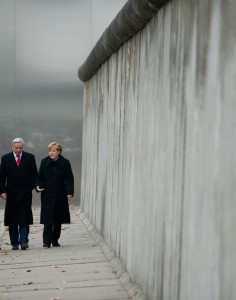
(AP Photo/Steffi Loos)
At 10am, the church bells rang out loudly, and a brass quartet played while the director of the Berlin Wall Memorial, Axel Klausmeier, escorted Chancellor Angela Merkel and Mayor Klaus Wowereit to the area. They were also joined by other officials from the city and federal governments, former Hungarian Prime Minister Milos Nemeth (who was key in 1989 in making democratic reforms and supporting the opening of the border with Austria, through which many East Germans left the socialist bloc), and representatives of people who were persecuted in East Germany. There were some short speeches, and then the officials and the rest of us put the roses we were given into the gaps between the concrete slabs in the rear wall.
The live television coverage of the events of the day began with this ceremony. We all then crossed the street to the small Chapel of Reconciliation (built on the site of where the much bigger Church of Reconciliation had long stood until the East Germans demolished it in 1985 since it stood in the death strip of the Berlin Wall and obscured the border guards’ view of the area complicating their efforts to see anyone trying to escape). Those of us who knew the incredibly creative and energetic pastor Manfred Fischer, who had been the church leader for decades and died suddenly of cardiac problems a year ago, really felt his loss at this service. Fischer had been the key person who pushed to create a Berlin Wall Memorial starting in 1990 and literally stood in front of bulldozers to stop them from removing all of the Wall at this site.
Several pastors and ministers celebrated the joy of the fall of the Wall and remember the people who were killed at the Wall as well as the Jewish victims of Kristallnacht on November 9, 1938. People who had lived in East Germany spoke of some of their happy memories of the fall of the Wall and their painful memories of life before that.
We then moved to the visitors’ center of the Berlin Wall Memorial a block away for speeches to mark the opening of the new permanent exhibit on the Berlin Wall from 1961-1989. The director of the Memorial had told me many times over the past couple of days that I was on the list of people who would be allowed into this part of the commemoration where Chancellor Merkel, Mayor Wowereit and the Klausmeier himself would give speeches. Yet when we arrived and had to show what color ribbon the security people had put on our wrist, my white ribbon was not the red ribbon that allowed you in. As I tried to explain that I was definitely supposed to be on the list, a long-time senior official of the Berlin government who was the driving force behind doing more to remember the history of the Berlin Wall, Rainer Klemke, suddenly practically picked me up and moved me past the people at the door. He had seen what was happened and decided to do whatever it took to get me in! That was a dramatic entrance.
The ceremony began upstairs in an incredibly moving way with a woman playing a Bach piece for solo violin. Dorothea Ebert had been born in East Germany in 1960 and tried to escape in 1983. She was caught and put in the most infamous women’s prison in East Germany, Hoeheneck. The thing that got her through her time in prison was playing her violin. Except she wasn’t allowed to have her violin. So she played in her imagination and just using her fingers in the air again and again and again. She had to do some hard labor, which hurt her hands. But she recovered afterwards and went on to become a violinist and teacher in Salzburg and Munich.
The speeches by the mayor, the chancellor and the memorial’s director all spoke of the importance of remembering the past (the good and the bad sides), helping the victims of the Wall, making sure such a non-democratic regime never comes to power again in Germany and supporting democracy and human rights in Germany, Europe and beyond. The mayor and chancellor remembered the dramatic developments of 1989 leading to the fall of the Wall. ,They emphasized that the lesson of 1989 is that things you thought impossible can suddenly be possible. Dreams can come true. Things don’t have to stay the way they are.
After the speeches, the violinist returned with a violist and cellist who are brothers and were born in East Germany. Their family, however, moved to West Germany because their father was under great pressure to join the communist party and did not want to. They played the first Beethoven of the day: a serenade for string trio, which was quite beautiful.
We were then invited to visit the new exhibit on the Berlin Wall once the chancellor and mayor were finished. The exhibit encompasses many more details of the entire history of the Berlin Wall and the world historical context of the Wall than the old, smaller exhibit did. It is in Geman and English and is clearly divided into sections that explain why the Wall was built, why it stood for 28 years and why it fell. There are videos to watch, recordings to listen to and much to see and read. Throughout the exhibit, at a lower level on the exhibit panels, making it easier for kids to read, there are explanations about the Wall given in a way that will engage young people. There is also a section of the exhibit telling the personal stories of a variety of individuals who came into contact with the Wall.
The next event after the Berlin Wall Memorial commemoration was the official ceremony hosted by the mayor at the beautiful concert hall, Konzerthaus, in the historic Gendarmenmarkt. I got a ride with one of my colleagues (we are both on the board of the Berlin Wall Association at the memorial), but it did not turn out to be easy to get around the balloons! So many streets were closed (as they had been of course when the Wall stood) that we kept driving around in circles until we finally found a way to get to a different part of town. The Wall had gone right down the middle of the street (Bernauer Strasse) where the Berlin Wall is located, and his car was on one side of that street, but we really needed to get to the other side to make our way toward the Gendarmenmarkt. It wasn’t easy, but we made it! There was a grand red carpet laid out in the middle of the grand stair case leading to the front doors of the Konzerthaus. That, however, was only for the top officials who would be arriving once we were seated. This time, in contrast to not having the right ribbon around my wrist at the memorial, for some reason I had a better seat than my colleagues. Who knows!
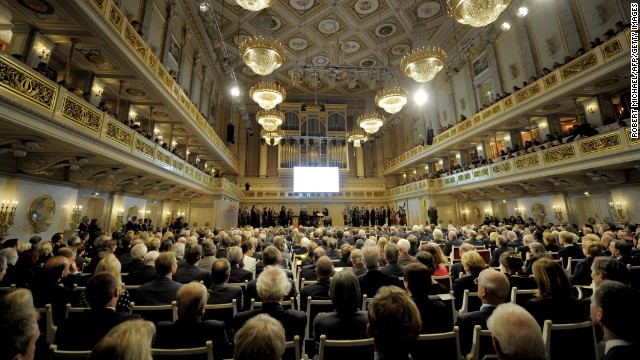
Just like at the Bundestag the other day, there were ushers in tails. It is a beautiful hall with elaborate paintings and gold trim all over the walls and ceilings and magnificent huge chandeliers. In addition to Mayor Wowereit, President Gauck, Mikhail Gorbachev (who got a huge, long standing ovation when he arrived and again later when then the mayor thanked him for coming), Lech Walesa (who also got a lot of applause), Martin Schulz (the President of the European Parliament) and all sorts of other German and foreign officials were present. Wowereit and Schulz gave speeches that emphasized not just what had happened in East Germany in 1989 but the European context of the revolutions of 1989. There was a wonderful audio recording (a “collage of sounds”) called “pieces of the Wall” by Antje Vowinckel that was played over the speakers in the room at the beginning featuring sounds that all had something to do with the Wall (like the sound of people chiseling off pieces of the Wall after Nov 9, 1989, or Reagan’s voice saying, “Mr. Gorbachev, tear down this Wall!”). Two people who were in the East German opposition in Leipzig (Kathrin Mahler Walther and Stefan Mueller) told their stories.
The most moving, uplifting part of the ceremony was the final musical performance: a part of Beethoven’s opera “Fidelio” called, “Oh God, what a moment!” (a perfect selection for remembering the fall of the Wall). Fidelio’s plot is about a woman who dresses as a man to persuade a prison warden to release her husband (who is a good man and was imprisoned for political reasons). As the conductor Ivan Fischer observed, the opera is about liberation and unification, very apropos for remembering 1989. He told us the selection would be performed as a flash mob with members of the choir standing up all over the audience and coming through various doors into the hall.
It was spectacular. There were singers and musicians from seven different orchestras and operas in Berlin. Most of them were up on the stage, but others came into the hall through doors behind us, to the side, up at the front, and up on the next level of the hall. We were surrounded by the glorious sound of Beethoven’s opera. It was unforgettable. We all stood and clapped for a long time when they finished.
And the day wasn’t over!
We had to find out way back in the car to the Berlin Wall Memorial where I had arranged for George Washington University to sponsor 11 of the 8,000 balloons along the Border of Light. (It cost nothing to do this: you just had to come up with a message for your balloon of less than 250 characters, all of which can be seen at fallofthewall25.com.) It turned out to be much easier to find our way back than it had been earlier. But as we got closer to the Berlin Wall Memorial, we could barely move the car, since there were thousands of people everywhere watching the movie on the big screens, looking at the outdoor parts of the memorial set up in the former death strip, and standing by their balloons getting ready to release them. We could not believe the masses of people. What an incredible success Christopher and Marc Bauder’s Border of Light has been.
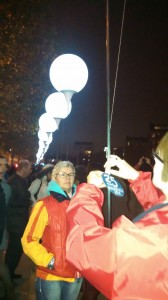 We parked the car and found the GW group. We have 4 students currently studying in Berlin, other GW students studying elsewhere in Europe who came for the weekend, and GW alumni living in Berlin. Four students sponsored balloons (one of whom did this for the class I am currently teaching at GW called The Two Germanys and the Cold War), as well as 4 GW alumni, myself, and 2 groups in Berlin where I serve on the board: the Berlin Wall Memorial Association and the Allied Museum of Berlin. As a balloon sponsor, we each got a red wind breaker that says “25 Years, Fall of the Wall, 2014.” We had to put them on and stand by our balloons starting at 7.
We parked the car and found the GW group. We have 4 students currently studying in Berlin, other GW students studying elsewhere in Europe who came for the weekend, and GW alumni living in Berlin. Four students sponsored balloons (one of whom did this for the class I am currently teaching at GW called The Two Germanys and the Cold War), as well as 4 GW alumni, myself, and 2 groups in Berlin where I serve on the board: the Berlin Wall Memorial Association and the Allied Museum of Berlin. As a balloon sponsor, we each got a red wind breaker that says “25 Years, Fall of the Wall, 2014.” We had to put them on and stand by our balloons starting at 7.
The students were already there when I arrived along with thousands of other people. We each all got a sort of lever that we had to insert into the base of the stand on which the balloon was resting and at a signal, we would push down the lever and release the balloon.
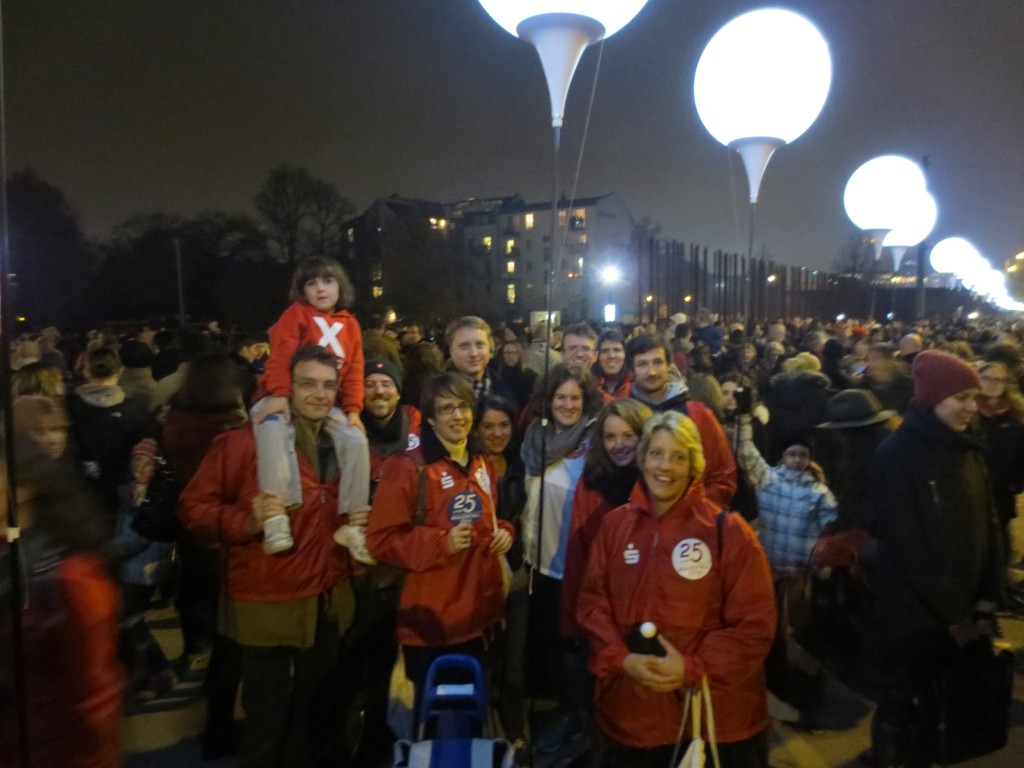
Hope Harrison and GW students
I had requested of the organizers of the Border of Light that our balloons be placed in front of the Chapel of Reconciliation, since one of our balloons was dedicated the memory of Manfred Fischer. It turned out that a big TV screen (albeit with no sound, but we were given little radios) was set up right near our balloons so we could see the big official party at the Brandenburg Gate with the mayor and the chancellor. Daniel Barenboim was conducting the Berlin Staatskapelle orchestra in Beethoven’s “Ode to Joy” (the 3rd and final performance of Beethoven I heard today) as the balloons began to be released at the Gate. Everyone started cheering where we were and getting excited to release our balloons. It took some time, since the balloons were released one after the other, not all at once.
People gathered all around us asking about how we could sponsor a balloon, what we had to do, what our message was, etc. It was such a festive atmosphere. Everyone wanted to be part of it. And I made some people standing by my balloon very happy. I needed to get to CNN to do an interview on CNN International in Potsdamer Platz, just 2 blocks from the Brandenburg Gate but a good distance from the Berlin Wall Memorial. I realized I couldn’t wait to release my balloon if I was going to make it to the interview. I already pushed the interview back to later in the day a few times with CNN and it was now planned for 8:30 and couldn’t be any later. So, I turned to some people standing next to me and asked if they wanted to take over my balloon. The first group for some reason didn’t want to. They were rather young and seemed uncertain whether they could do it. But then I asked a couple nearby and they were so excited and had huge smiles on their faces when I offered them the chance to take over my balloon and release it. They said they lived around the corner and that this meant so much to them.
As I weaved by way through the crowd, I saw the balloons in the next block being released and then coming up to where our group was. It really did look beautiful with the illuminated balloons floating one by one up into the sky. (They are made of a biodegradable material so they won’t do any damage once they come back to the ground.)

It took far longer than I had hoped to get a taxi a couple of blocks away but eventually I made it, although I had to walk (very quickly!) the final 5 blocks since the streets near the Brandenburg Gate and Potsdamer Platz were closed off. I finally made it and was wisked up to the roof of the building with a fantastic view of the Brandenburg Gate. Before I knew it, I was sitting outside with the host talking about the history of the Berlin Wall and the celebration today in Berlin.
After the interview, I walked into a nearby hotel and asked them to get me a taxi back to my own hotel. The street in front of the hotel was closed, however, and they said they couldn’t call a taxi. But they wanted to help me. So they told me not to say anything (hence, I’m not saying the name of the hotel), but that they would in fact have someone drive me in a hotel car to my own hotel. Now that’s a nice hotel! Well, when the nice doorman got me to my hotel just 5 minutes away, he jumped out of the car, opened by door, helped me out and kissed my hand! Now that was a nice way to end an incredible day celebrating the 25th anniversary of the fall of the Berlin Wall.
POSTSCRIPT – NOVEMBER 12
There is now an incredible story now about one of our George Washington University balloon messages for the official 25th anniversary of the fall of the Wall in Berlin. As you know the main official celebration in Berlin involved the installation of 8,000 balloons (called a Lichtgrenze, of Border of Light) along more than nine miles of the former path of the Berlin Wall.
I arranged for GW to have 11 balloons. I had one; my current undergrad class (Hist. 3168, The Two Germanys and the Cold War) had one; 3 GW undergrads had balloons; 4 GW alumni had balloons, and I offered 2 balloons to 2 organizations in Berlin where I am on the board: the Allied Museum (documenting the history of the US, Great Britain and France preserving the freedom of West Berlin and West Germany during the Cold War) and the Berlin Wall Memorial Association. This is all relevant to the story I want to tell you, so bear with me!
The balloon sponsored by the Berlin Wall Memorial Association was dedicated to Pastor Manfred Fischer who since 1977 had been the pastor of the church located at what became the Berlin Wall Memorial, the Church of Reconciliation. Fischer died suddenly due to cardiac problems a year ago. He is the reason the Berlin Wall Memorial exists. He fought from early days in 1990 to preserve a section of the Wall at Bernauer Strasse and turn it into a memorial. He even stood in front of bulldozers to stop them from taking down the Wall there. He is the person who invited me to be a member of the board of the Berlin Wall Association, making me the only non-German member of the board. I wanted one of our balloons to be dedicated to him, and I received permission from the official organizers of the Border of Light for our 11 GW balloons to be located directly in front of Fisher’s Chapel of Reconciliation (which had been built in 2000, since the East Germans blew up the Church of Reconciliation in 1985 to remove it from the middle of the “death strip” of the Berlin Wall where it was in their way to have a clear view to see whether anyone was trying to escape).
On the night of the 25th anniversary of the fall of the Wall, Sunday, Nov. 9, we each attached a hand-written message to our balloon and released our balloons into the air at the moment we were given the go-ahead (which is what happened with all 8,000 balloons). The messages have been landing all over Berlin since then and one has even been found hundreds of miles away in Latvia.
By absolutely incredible, wonderful coincidence, the message that one of our students wrote (Georges Gautherin, who is pursuing a master’s at the Elliott School in European and Eurasian Studies and is studying in Berlin this semester) landed yesterday in the backyard of Manfred Fischer’s widow, six miles away from where Georges released the balloon at the Berlin Wall Memorial, which had in effect been founded by her husband. Georges’ message was: “The fall of the Berlin Wall is one of the most significant events in modern history.” Fischer’s widow was incredibly moved and could not believe the balloon and its message landed in her yard. I can’t either.
Hope M. Harrison
—————————————————————
 Hope M. Harrison, an associate professor of history and international affairs at George Washington University. She published a prize-winning book in 2003 on the East German and Soviet decision to build the Berlin Wall. An expanded and updated version of the book was published in Germany in 2011 to glowing reviews. Co-founder and co-director of GW’s Cold War Group, she is fluent in Russian and German and worked extensively in archives in Moscow and Berlin. Her current book project examines the Berlin Wall as a contested site of memory in Germany from 1989-2011. She is currently working on a book manuscript for Cambridge University Press entitled After the Wall: Memory and the New Germany, 1989 to the Present.
Hope M. Harrison, an associate professor of history and international affairs at George Washington University. She published a prize-winning book in 2003 on the East German and Soviet decision to build the Berlin Wall. An expanded and updated version of the book was published in Germany in 2011 to glowing reviews. Co-founder and co-director of GW’s Cold War Group, she is fluent in Russian and German and worked extensively in archives in Moscow and Berlin. Her current book project examines the Berlin Wall as a contested site of memory in Germany from 1989-2011. She is currently working on a book manuscript for Cambridge University Press entitled After the Wall: Memory and the New Germany, 1989 to the Present.
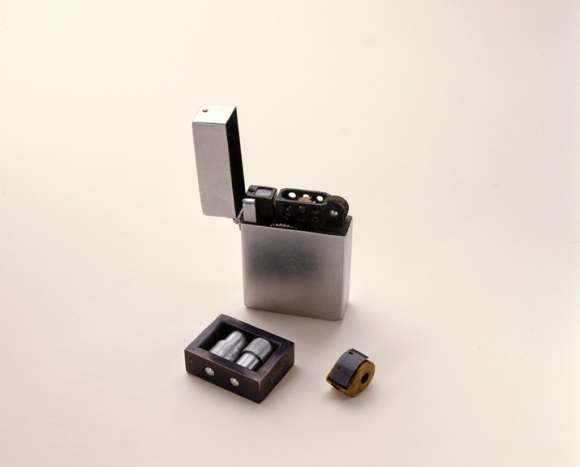 Made by the United States for use in Japan, this invention came on the tail of Germany’s wristwatch cam. In the 1950s, US Air Force Intelligence officers could capture images by lighting a cigarette. The gadget was simple yet effective, as long as the camera in the lighter was pointed right at the subject.
Made by the United States for use in Japan, this invention came on the tail of Germany’s wristwatch cam. In the 1950s, US Air Force Intelligence officers could capture images by lighting a cigarette. The gadget was simple yet effective, as long as the camera in the lighter was pointed right at the subject.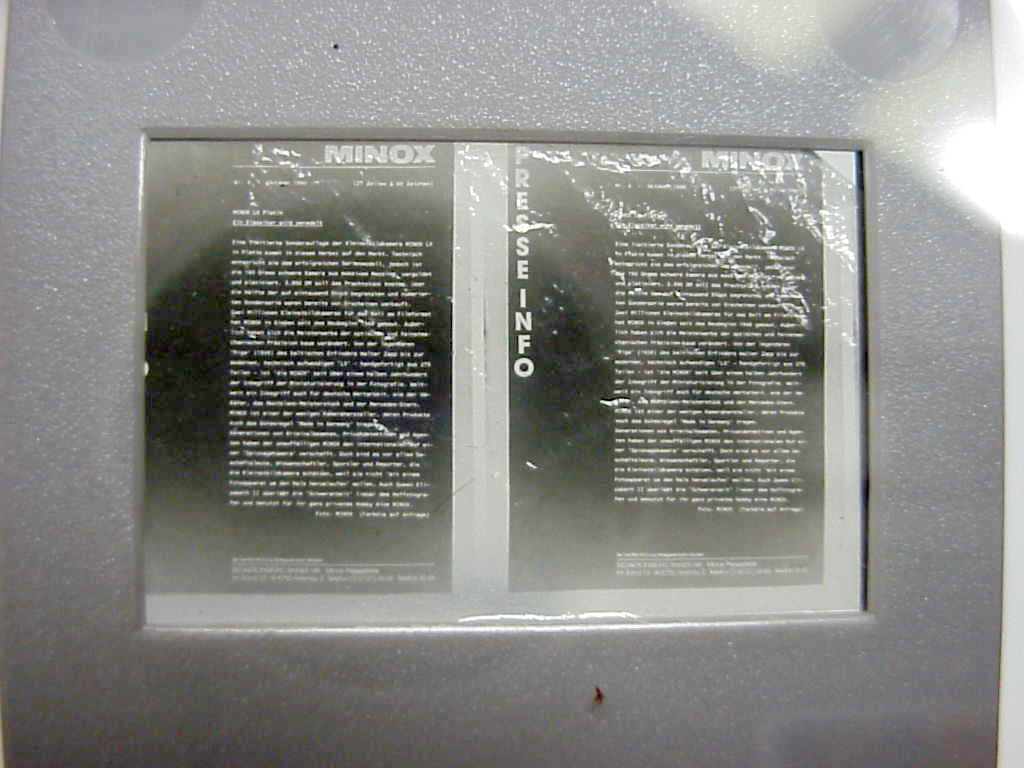 Invented by the KGB, this type of film lacked the traditional thick backing and could be rolled up tightly for easier storage of sensitive images.
Invented by the KGB, this type of film lacked the traditional thick backing and could be rolled up tightly for easier storage of sensitive images.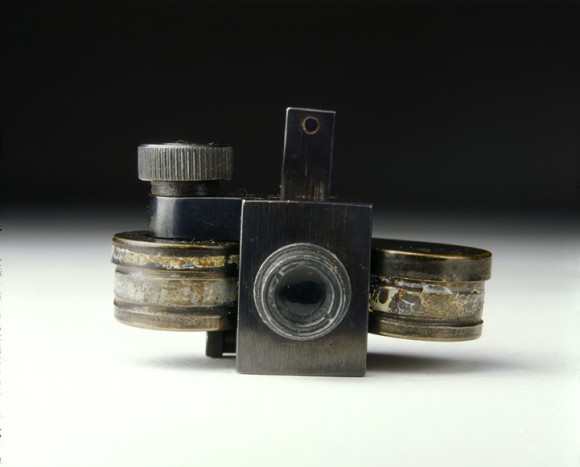 German innovation continued with the development of the microdot camera in the 1960s. This camera had the ability to shrink entire documents worth of text data into the size of a period printed in the newspapers. To recover the data, a special magnifying glass was required. The data was often embedded in postcards or envelopes, so the next time you receive a letter take a close look at the punctuation marks. You never know what you could find.
German innovation continued with the development of the microdot camera in the 1960s. This camera had the ability to shrink entire documents worth of text data into the size of a period printed in the newspapers. To recover the data, a special magnifying glass was required. The data was often embedded in postcards or envelopes, so the next time you receive a letter take a close look at the punctuation marks. You never know what you could find.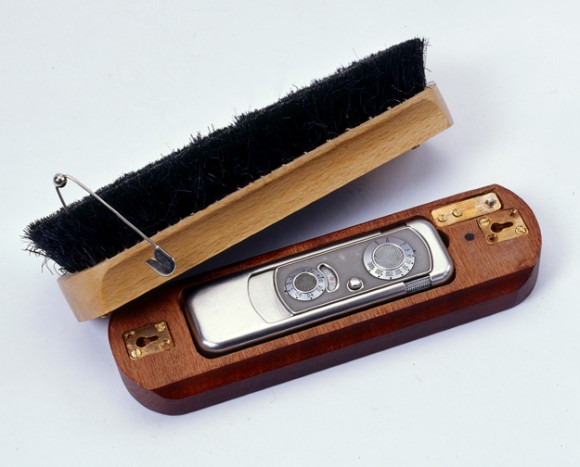 In the 1960s, the Germans developed a hairbrush concealment accessory for the Minox camera. The Minox subminiature camera was an essential spy gadget. The small but high-resolution lens could capture 50 quality pictures without reloading.
In the 1960s, the Germans developed a hairbrush concealment accessory for the Minox camera. The Minox subminiature camera was an essential spy gadget. The small but high-resolution lens could capture 50 quality pictures without reloading. It’s easy to forget that not all cameras are on the ground. Stationed above the atmosphere are satellites capable of taking images of Earth’s inhabitants. There is no place to hide so make sure not to get caught.
It’s easy to forget that not all cameras are on the ground. Stationed above the atmosphere are satellites capable of taking images of Earth’s inhabitants. There is no place to hide so make sure not to get caught.
